David Lloyd George
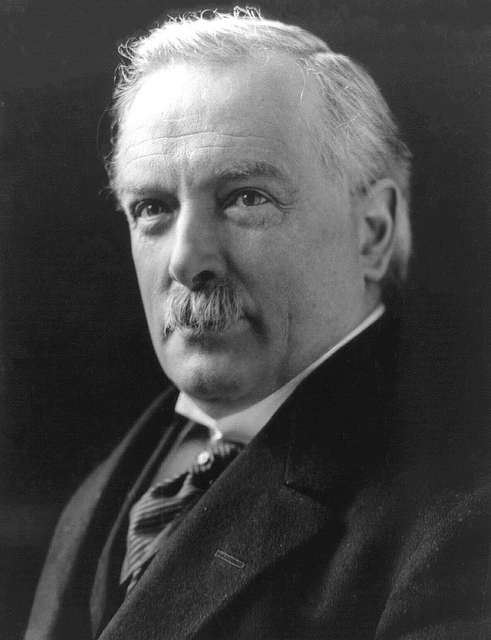
David Lloyd George

The Right Honourable David Lloyd George OM PC | |
|---|---|
| Prime Minister of the United Kingdom | |
| In office 6 December 1916 – 19 October 1922 | |
| Monarch | George V |
| Preceded by | H. H. Asquith |
| Succeeded by | Bonar Law |
| Leader of the Liberal Party | |
| In office 14 October 1926 – 4 November 1931 | |
| Preceded by | H. H. Asquith |
| Succeeded by | Herbert Samuel |
| Secretary of State for War | |
| In office 6 July 1916 – 5 December 1916 | |
| Prime Minister | H. H. Asquith |
| Preceded by | The Earl Kitchener |
| Succeeded by | The Earl of Derby |
| Minister of Munitions | |
| In office 25 May 1915 – 9 July 1916 | |
| Prime Minister | H. H. Asquith |
| Preceded by | Office created |
| Succeeded by | Edwin Montagu |
| Chancellor of the Exchequer | |
| In office 12 April 1908 – 25 May 1915 | |
| Prime Minister | H. H. Asquith |
| Preceded by | H. H. Asquith |
| Succeeded by | Reginald McKenna |
| President of the Board of Trade | |
| In office 10 December 1905 – 12 April 1908 | |
| Prime Minister | Henry Campbell-Bannerman H. H. Asquith |
| Preceded by | The Marquess of Salisbury |
| Succeeded by | Winston Churchill |
| Father of the House | |
| In office 31 May 1929 – 13 February 1945 | |
| Preceded by | T. P. O'Connor |
| Succeeded by | The Earl Winterton |
| Member of Parliament for Carnarvon Boroughs | |
| In office 10 April 1890 – 13 February 1945 | |
| Preceded by | Edmund Swetenham[4] |
| Succeeded by | Seaborne Davies |
| Member of the House of Lords Lord Temporal | |
| In office 1 January 1945 – 26 March 1945 Hereditary peerage | |
| Preceded by | peerage created |
| Succeeded by | The 2nd Earl Lloyd-George of Dwyfor |
| Personal details | |
| Born | (1863-01-17)17 January 1863 Chorlton-on-Medlock, Manchester, Lancashire, England |
| Died | 26 March 1945(1945-03-26)(aged 82) Tŷ Newydd, Caernarfonshire, Wales |
| Resting place | Llanystumdwy, Gwynedd, Wales |
| Citizenship | British |
| Nationality | Welsh |
| Political party | Liberal(1890–1916 and 1924–45) Coalition Liberal(1916-22) National Liberal(1922–23) |
| Spouse(s) |
|
| Children | 5, including Richard, Gwilym and Lady Megan |
| Parents |
|
| Profession | solicitor, politician |
| Signature | |
As Chancellor of the Exchequer (1908–1915) during H. H. Asquith's tenure as Prime Minister, Lloyd George was a key figure in the introduction of many reforms which laid the foundations of the modern welfare state. His most important role came as the highly energetic Prime Minister of the Wartime Coalition Government (1916–22), during and immediately after the First World War. He was a major player at the Paris Peace Conference of 1919 that reordered Europe after the defeat of the Central Powers. Although he remained Prime Minister after the 1918 general election, the Conservatives were the largest party in the coalition, with the Liberals split between those loyal to Lloyd George, and those still supporting Asquith. He became the leader of the Liberal Party in the late 1920s, but it grew even smaller and more divided. By the 1930s he was a marginalised and widely mistrusted figure. He gave weak support to the war effort during the Second World War amidst fears that he was favourable toward Germany.
The Right Honourable David Lloyd George OM PC | |
|---|---|
| Prime Minister of the United Kingdom | |
| In office 6 December 1916 – 19 October 1922 | |
| Monarch | George V |
| Preceded by | H. H. Asquith |
| Succeeded by | Bonar Law |
| Leader of the Liberal Party | |
| In office 14 October 1926 – 4 November 1931 | |
| Preceded by | H. H. Asquith |
| Succeeded by | Herbert Samuel |
| Secretary of State for War | |
| In office 6 July 1916 – 5 December 1916 | |
| Prime Minister | H. H. Asquith |
| Preceded by | The Earl Kitchener |
| Succeeded by | The Earl of Derby |
| Minister of Munitions | |
| In office 25 May 1915 – 9 July 1916 | |
| Prime Minister | H. H. Asquith |
| Preceded by | Office created |
| Succeeded by | Edwin Montagu |
| Chancellor of the Exchequer | |
| In office 12 April 1908 – 25 May 1915 | |
| Prime Minister | H. H. Asquith |
| Preceded by | H. H. Asquith |
| Succeeded by | Reginald McKenna |
| President of the Board of Trade | |
| In office 10 December 1905 – 12 April 1908 | |
| Prime Minister | Henry Campbell-Bannerman H. H. Asquith |
| Preceded by | The Marquess of Salisbury |
| Succeeded by | Winston Churchill |
| Father of the House | |
| In office 31 May 1929 – 13 February 1945 | |
| Preceded by | T. P. O'Connor |
| Succeeded by | The Earl Winterton |
| Member of Parliament for Carnarvon Boroughs | |
| In office 10 April 1890 – 13 February 1945 | |
| Preceded by | Edmund Swetenham[4] |
| Succeeded by | Seaborne Davies |
| Member of the House of Lords Lord Temporal | |
| In office 1 January 1945 – 26 March 1945 Hereditary peerage | |
| Preceded by | peerage created |
| Succeeded by | The 2nd Earl Lloyd-George of Dwyfor |
| Personal details | |
| Born | (1863-01-17)17 January 1863 Chorlton-on-Medlock, Manchester, Lancashire, England |
| Died | 26 March 1945(1945-03-26)(aged 82) Tŷ Newydd, Caernarfonshire, Wales |
| Resting place | Llanystumdwy, Gwynedd, Wales |
| Citizenship | British |
| Nationality | Welsh |
| Political party | Liberal(1890–1916 and 1924–45) Coalition Liberal(1916-22) National Liberal(1922–23) |
| Spouse(s) |
|
| Children | 5, including Richard, Gwilym and Lady Megan |
| Parents |
|
| Profession | solicitor, politician |
| Signature | |
Upbringing and early life
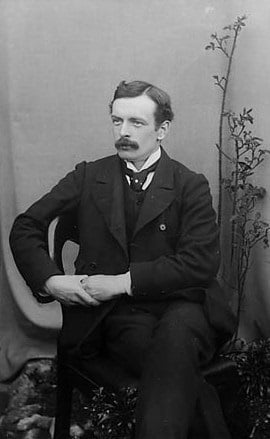
Lloyd George circa 1890
Lloyd George was born on 17 January 1863 in Chorlton-on-Medlock, Manchester, to Welsh parents, and was brought up as a Welsh-speaker. He is so far the only British Prime Minister to have been Welsh[2] and to have spoken English as a second language.[7]
His father, William George, had been a teacher in both London and Liverpool. He also taught in the Hope Street Sunday Schools, which were administered by the Unitarians, where he met Unitarian minister Dr James Martineau.[8] In March of the same year, on account of his failing health, William George returned with his family to his native Pembrokeshire. He took up farming but died in June 1864 of pneumonia, aged 44. His widow, Elizabeth George (1828–96), sold the farm and moved with her children to her native Llanystumdwy in Caernarfonshire, where she lived in a cottage known as Highgate with her brother Richard Lloyd (1834–1917), who was a shoemaker, a minister (in the Scottish Baptists and then the Church of Christ),[9] and a strong Liberal. Lloyd George was educated at the local Anglican school Llanystumdwy National School and later under tutors. Lloyd George's uncle was a towering influence on him, encouraging him to take up a career in law and enter politics; his uncle remained influential up until his death at age 83 in February 1917, by which time his nephew had become Prime Minister. He added his uncle's surname to become "Lloyd George". His surname is usually given as "Lloyd George" and sometimes as "George". The influence of his childhood showed through in his entire career, as he attempted to aid the common man at the expense of what he liked to call "the Dukes" (that is, the aristocracy); however, biographer John Grigg argued that Lloyd George's childhood was nowhere near as poverty-stricken as he liked to suggest.[10]
Brought up a devout evangelical, as a young man he suddenly lost his religious faith. Biographer Don Cregier says he became "a Deist and perhaps an agnostic, though he remained a chapel-goer and connoisseur of good preaching all his life". He kept quiet about this, and was, according to Frank Owen, for 25 years "one of the foremost fighting leaders of a fanatical Welsh Nonconformity".[11][12][13]
It was also during this period of his life that Lloyd George first became interested in the issue of land ownership. As a young man he read books by Thomas Spence, John Stuart Mill and Henry George, as well as pamphlets written by George Bernard Shaw and Sidney Webb of the Fabian Society on the issue of land ownership.[14] By the age of twenty-one, he had already read and taken notes on Henry George's Progress and Poverty.[15][16] This strongly influenced Lloyd George's politics later in life; the People's Budget drew heavily on Georgist tax reform ideas.
Articled to a firm of solicitors in Porthmadog, Lloyd George was admitted in 1884 after taking Honours in his final law examination and set up his own practice in the back parlour of his uncle's house in 1885. The practice flourished, and he established branch offices in surrounding towns, taking his brother William into partnership in 1887. Although many Prime Ministers have been barristers, Lloyd George is to date the only solicitor to have held that office.[17]
By then he was politically active, having campaigned for the Liberal Party in the 1885 election, attracted by Joseph Chamberlain's "unauthorised programme" of reforms. The election resulted firstly in a stalemate with neither the Liberals nor the Conservatives having a majority, the balance of power being held by the Irish Parliamentary Party. William Gladstone's proposal to bring about Irish Home Rule split the party, with Chamberlain eventually leading the breakaway Liberal Unionists. Uncertain of which wing to follow, Lloyd George carried a pro-Chamberlain resolution at the local Liberal Club and travelled to Birmingham to attend the first meeting of Chamberlain's National Radical Union, but he had his dates wrong and arrived a week too early. In 1907 he was to say that he thought Chamberlain's plan for a federal solution correct in 1886 and still thought so, that he preferred the unauthorised programme to the Whig-like platform of the official Liberal Party, and that, had Chamberlain proposed solutions to Welsh grievances such as land reform and disestablishment, he, together with most Welsh Liberals, would have followed Chamberlain.[18]
He married Margaret Owen, the daughter of a well-to-do local farming family, on 24 January 1888.[19] Also in that year, he and other young Welsh Liberals founded a monthly paper Udgorn Rhyddid (Bugle of Freedom). They also won the Llanfrothen burial case, which established the right of Nonconformists to be buried according to their own denominational rites in parish burial grounds, a right given by the Burial Laws Amendment Act 1880 but which had up to then been ignored by the Anglican clergy. On Lloyd George's advice, a Baptist burial party broke open a gate to a cemetery which had been locked against them by the vicar. The vicar sued them for trespass and the local judge misrecorded the jury's verdict and found in his favour, awakening suspicions of bias by the local Tory landowning class. Lloyd George's clients won on appeal to the Divisional Court of Queen's Bench in London, where Lord Chief Justice Coleridge found in their favour. It was this case, which was hailed as a great victory throughout Wales, and his writings in Udgorn Rhyddid that led to his adoption as the Liberal candidate for Carnarvon Boroughs on 27 December 1888.[18][20]
In 1889 he became an Alderman on Carnarvonshire County Council which had been created by the Local Government Act 1888. At that time he appeared to be trying to create a separate Welsh national party modelled on Parnell's Irish Parliamentary Party and worked towards a union of the North and South Wales Liberal Federations. For the same county Lloyd George would also become a JP (1910)[21] and chairman of Quarter Sessions (1929–38),[22] and Deputy Lieutenant in 1921.[21]
Member of Parliament
Lloyd George was returned as Liberal MP for Carnarvon Boroughs – by a margin of 18 votes – in a by-election on 10 April 1890, following the death of the Conservative member Edmund Swetenham.[23] He sat with an informal grouping of Welsh Liberal members who had a programme of disestablishing and disendowing the Church of England in Wales, temperance reform, and Welsh home rule. He would remain an MP for the same constituency until 1945, 55 years later.[24]
As backbench members of the House of Commons were not paid at that time, he supported himself and his growing family by continuing to practise as a solicitor, opening an office in London under the name of 'Lloyd George and Co.' and continuing in partnership with William George in Criccieth. In 1897 he merged his growing London practice with that of Arthur Rhys Roberts (who was to become Official Solicitor) under the name of 'Lloyd George, Roberts and Co.'.[25]
He served as the legal adviser of Theodor Herzl in his negotiations with the British government regarding the Uganda Scheme, proposed as an alternative homeland for the Jews due to Turkish refusal to grant a charter for Jewish settlement in Palestine.[26]
Issues
He was soon speaking on Liberal issues (particularly temperance – the "local option" – and national as opposed to denominational education) throughout England as well as Wales. During the next decade Lloyd George campaigned in Parliament largely on Welsh issues and in particular for disestablishment and disendowment of the Church of England. He wrote extensively for Liberal papers such as the Manchester Guardian. When Gladstone retired in 1894 after the defeat of the second Home Rule Bill, the Welsh Liberal members chose him to serve on a deputation to William Harcourt to press for specific assurances on Welsh issues; when those were not provided, they resolved to take independent action if the government did not bring a bill for disestablishment. When that was not forthcoming, he and three other Welsh Liberals (D. A. Thomas, Herbert Lewis and Frank Edwards) refused the whip on 14 April 1894, but accepted Lord Rosebery's assurance and rejoined the official Liberals on 29 May. Thereafter he devoted much time to setting up branches of Cymru Fydd (Young Wales), which, he said, would in time become a force like the Irish National Party. He abandoned this idea after being criticised in Welsh newspapers for bringing about the defeat of the Liberal Party in the 1895 election and at a meeting in Newport on 16 January 1896 of the South Wales Liberal Federation, led by D. A. Thomas, he was shouted down.[27]
Lloyd George also supported the idea of Pan-Celtic unity and gave a speech at the 1904 Pan-Celtic Congress in Caernarfon.[28]
Opposes Boer War
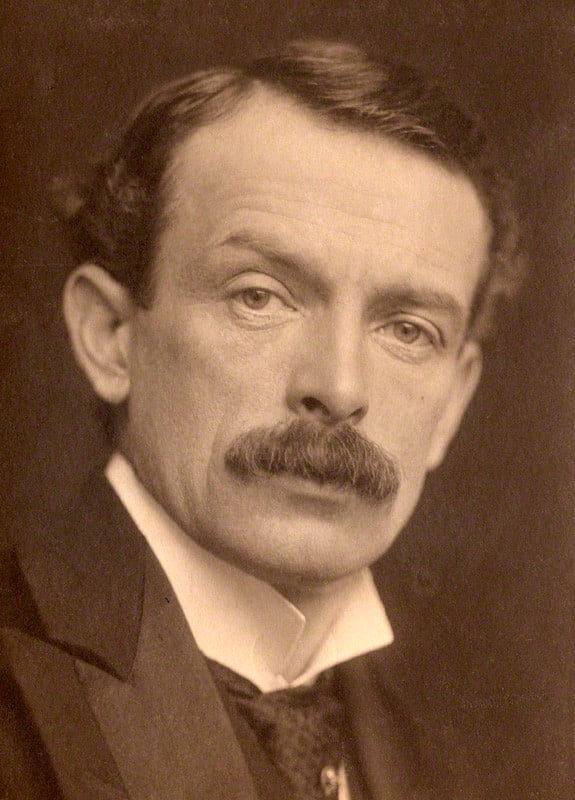
David Lloyd George in 1902
Lloyd George had been impressed by his journey to Canada in 1899. Although sometimes wrongly supposed – both at the time and subsequently – to be a Little Englander, he was not an opponent of the British Empire per se, but in a speech at Birkenhead (21 November 1901) he stressed that it needed to be based on freedom, including for India, not "racial arrogance".[29] Consequently, he gained national fame by displaying vehement opposition to the Second Boer War.[30]
Following Rosebery's lead he based his attack firstly on what were supposed to be Britain's war aims – remedying the grievances of the Uitlanders and in particular the claim that they were wrongly denied the right to vote, saying "I do not believe the war has any connection with the franchise. It is a question of 45% dividends" and that England (which did not then have universal male suffrage) was more in need of franchise reform than the Boer republics. A second attack came on the cost of the war, which, he argued, prevented overdue social reform in England, such as old age pensions and workmen's cottages. As the fighting continued his attacks moved to its conduct by the generals, who, he said (basing his words on reports by William Burdett-Coutts in The Times), were not providing for the sick or wounded soldiers and were starving Boer women and children in concentration camps. But his major thrusts were reserved for the Chamberlains, accusing them of war profiteering through the family company Kynoch Ltd, of which Chamberlain's brother was Chairman. The firm had won tenders to the War Office though its prices were higher than some of its competitors. After speaking at a meeting in Birmingham Lloyd George had to be smuggled out disguised as a policeman, as his life was in danger from the mob. At this time the Liberal Party was badly split as H. H. Asquith, R. B. Haldane and others were supporters of the war and formed the Liberal Imperial League.[31]
Opposes Education Act of 1902
Lloyd George was the main spokesman for the Nonconformists, and they made a major issue out of the government's Education Act 1902. It provided funding for Church of England schools, paid out of local taxation. The bill passed but opposition to it helped reunite the Liberals. His successful amendment that county councils need only fund those schools where the buildings were in good repair served to make the Act a dead letter in Wales, where the counties were able to show that most Church of England schools were in poor repair. Having already gained national recognition for his anti-Boer War campaigns, his leadership of the attacks on the Education Act gave him a strong parliamentary reputation and marked him as a likely future cabinet member.[32]
The Act served to reunify the Liberals after their divisions over the Boer War, and to increase Nonconformist influence in the party, which then included educational reform as policy in the 1906 election, which resulted in a Liberal landslide.[33]
President of the Board of Trade (1905–1908)
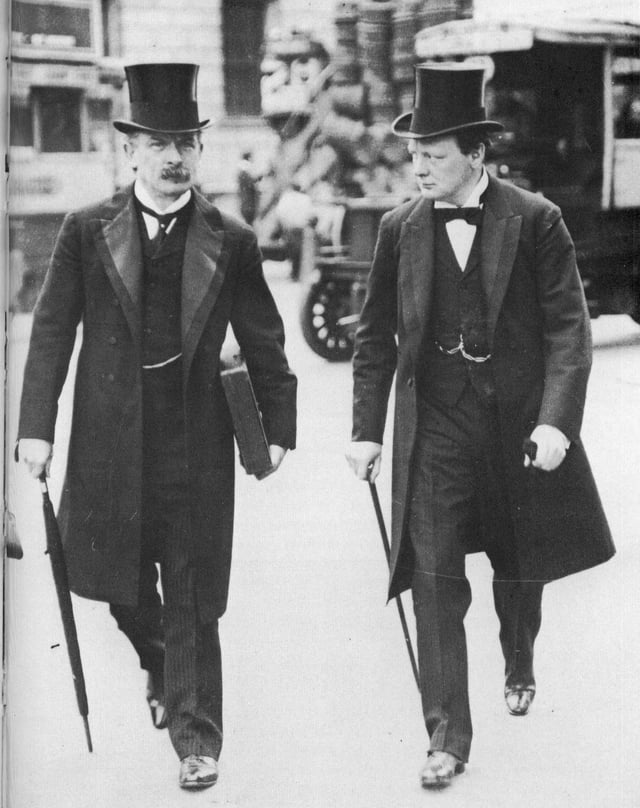
David Lloyd George and Winston Churchill in 1907
In 1905, Lloyd George entered the new Liberal Cabinet of Sir Henry Campbell-Bannerman as President of the Board of Trade.[34]
The first priority on taking office was repeal of the 1902 Education Act. Lloyd George took the lead along with Augustine Birrell, President of the Board of Education. Lloyd George appears to have been the dominant figure on the committee drawing up the bill in its later stages, and insisted that the bill create a separate education committee for Wales. Birrell complained privately that the bill, introduced in the Commons on 9 April 1906, owed more to Lloyd George and that he himself had had little say in its contents.[35] The bill passed the House of Commons greatly amended, but was completely mangled by the House of Lords.[33] For the rest of the year, Lloyd George made numerous public speeches attacking the House of Lords for mutilating the bill with wrecking amendments, in defiance of the Liberals’ electoral mandate to reform the 1902 Act. Lloyd George was rebuked by King Edward VII for these speeches: the Prime Minister defended him to the Kings’s secretary Francis Knollys, stating that his behaviour in Parliament was more constructive but that in speeches to the public “the combative spirit seems to get the better of him”.[35] No compromise was possible and the bill was abandoned, allowing the 1902 Act to continue in effect.[33] As a result of Lloyd George’s lobbying, a separate department for Wales[3] was created within the Board of Education.[35]
Nonconformists were bitterly upset by the failure of the Liberal Party to carry through on its most important promise to them, and over time their support for the Liberal Party slowly fell away.[36]
At the Board of Trade Lloyd George introduced legislation on many topics, from merchant shipping and the Port of London to companies and railway regulation. His main achievement was in stopping a proposed national strike of the railway unions by brokering an agreement between the unions and the railway companies. While almost all the companies refused to recognise the unions, Lloyd George persuaded the companies to recognise elected representatives of the workers who sat with the company representatives on conciliation boards—one for each company. If those boards failed to agree then there was a central board.[37]
Chancellor of the Exchequer (1908–1915)
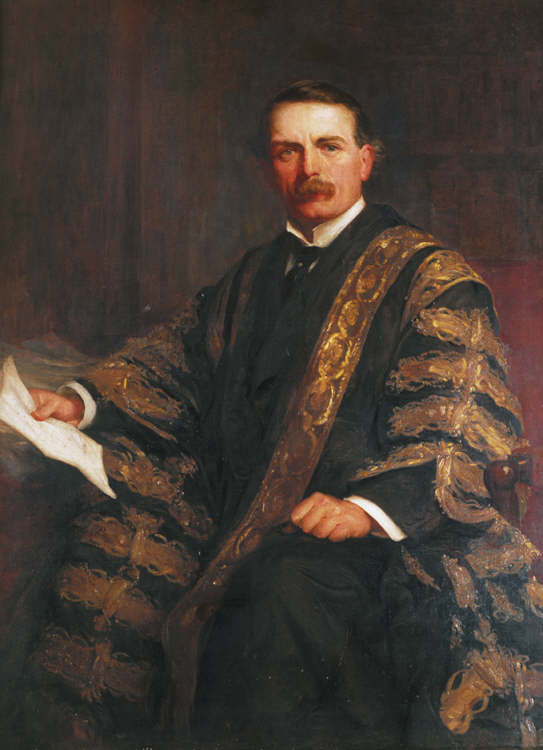
Portrait of Chancellor Lloyd George by Christopher Williams (1911)
On Campbell-Bannerman's death he succeeded Asquith, who had become Prime Minister, as Chancellor of the Exchequer from 1908 to 1915.[38] While he continued some work from the Board of Trade—for example, legislation to establish the Port of London Authority and to pursue traditional Liberal programmes such as licensing law reforms—his first major trial in this role was over the 1908–1909 Naval Estimates. The Liberal manifesto at the 1906 general election included a commitment to reduce military expenditure. Lloyd George strongly supported this, writing to Reginald McKenna, First Lord of the Admiralty, "the emphatic pledges given by all of us at the last general election to reduce the gigantic expenditure on armaments built up by the recklessness of our predecessors." He then proposed the programme be reduced from six to four dreadnoughts. This was adopted by the government, but there was a public storm when the Conservatives, with covert support from the First Sea Lord, Admiral Jackie Fisher, campaigned for more with the slogan "We want eight and we won't wait". This resulted in Lloyd George's defeat in Cabinet and the adoption of estimates including provision for eight dreadnoughts.[39]
People's Budget, 1909
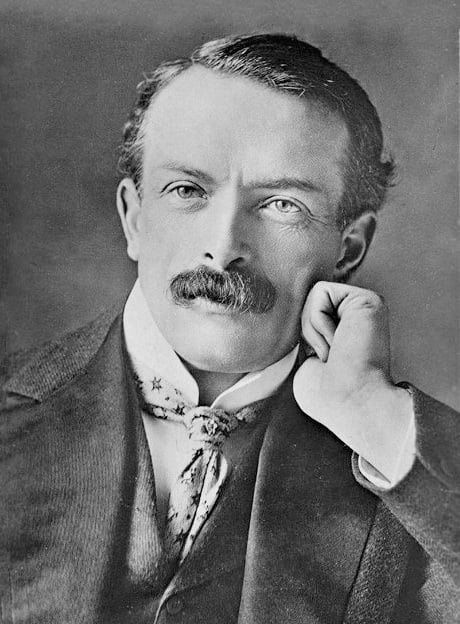
David Lloyd George circa 1911
In 1909 Lloyd George introduced his People's Budget, imposing a 20% tax on the unearned increase in value of land, payable at death of the owner or sale of the land, and ½ d. on undeveloped land and minerals, increased death duties, a rise in income tax, and the introduction of Supertax on income over £3,000.[40] There were taxes also on luxuries, alcohol, and tobacco, so that money could be made available for the new welfare programmes as well as new battleships. The nation's landowners (well represented in the House of Lords) were intensely angry at the new taxes, mostly at the proposed very high tax on land values, but also because the instrumental redistribution of wealth could be used to detract from an argument for protective tariffs.[41]
The immediate consequences included the end of the Liberal League, and Rosebery breaking friendship with the Liberal Party, which in itself was for Lloyd George a triumph. He had won the case of social reform without losing the debate on Free Trade.[42] Arthur Balfour denounced the budget as "vindictive, inequitable, based on no principles, and injurious to the productive capacity of the country."[43] Roy Jenkins described it as the most reverberating since Gladstone's in 1860.[44]
In the House of Commons Lloyd George gave a brilliant account of the budget, which was attacked by the Conservatives. On the stump, notably at his Limehouse speech in 1909, he denounced the Conservatives and the wealthy classes with all his very considerable oratorical power. The budget was defeated by the Conservative majority in the House of Lords. The elections of 1910 narrowly upheld the Liberal government. The 1909 budget was passed on 28 April 1910 by the Lords, and received the Royal Assent on the 29th.[45][46] Subsequently, the Parliament Act 1911 curtailed the veto power of the House of Lords.
Although old-age pensions had already been introduced by Asquith as Chancellor, Lloyd George was largely responsible for the introduction of state financial support for the sick and infirm (known colloquially as "going on the Lloyd George" for decades afterwards)—legislation referred to as the Liberal Reforms. Lloyd George also succeeded in putting through Parliament his National Insurance Act 1911, making provision for sickness and invalidism, and a system of unemployment insurance. He was helped in his endeavours by forty or so backbenchers who regularly pushed for new social measures, often voted with Labour MPs.[47] These social reforms in Britain were the beginnings of a welfare state and fulfilled the aim of dampening down the demands of the growing working class for rather more radical solutions to their impoverishment.
Under his leadership after 1909 the Liberals extended minimum wages to farm workers.[48]
Mansion House Speech, 1911
Lloyd George was considered an opponent of war until the Agadir Crisis of 1911, during which he gave a stirring and patriotic speech at Mansion House on 21 July 1911. Grey was aghast and felt that the Chancellor was more qualified to be Foreign Secretary than he was; German opinion recognised that Britain would resist further German aggression.[49] Haldane and Lloyd George were among the minority in the Cabinet who were pro-German, on grounds of a shared religion, philosophy, artistic culture and scientific enquiry. Germany blamed Lloyd George for doing "untold harm both with regard to German public opinion and the negotiations...namely, to the despatch of the German warship to Agadir", and citing Count Metternich "...Mr Lloyd George's speech came upon us like a thunderbolt"[50]
Marconi scandal 1913
In 1913 Lloyd George, along with Rufus Isaacs, the Attorney General, was involved in the Marconi scandal. Accused of speculating in Marconi shares on the inside information that they were about to be awarded a key government contract (which would have caused them to increase in value), he told the House of Commons that he had not speculated in the shares of "that company". He had in fact bought shares in the American Marconi Company.[51]
Welsh Church Act 1914
The Church of England no longer had majority adherence in most parts of Wales in preference to Wales-led Protestantism, in particular Methodism. Lloyd George had long called for disestablishment and was instrumental in introducing the Welsh Church Act 1914 which disestablished the Anglican Church in Wales (though, upon the outbreak of war, the actual coming into force of the Act was postponed by the Suspensory Act 1914 until 1920), removing the opportunity of the six Welsh Bishops in the new Church in Wales to sit in the House of Lords and removing (disendowing) certain pre-1662 property rights.[52][53]
First World War
Lloyd George was as surprised as almost everyone else by the outbreak of the First World War. On 23 July 1914, almost a month after the assassination of Archduke Franz Ferdinand of Austria and on the eve of the Austro-Hungarian ultimatum to Serbia, he made a speech advocating "economy" in the House of Commons, saying that Britain's relations with Germany were better than for many years.[54] On 27 July he told C. P. Scott of the Manchester Guardian that Britain would keep out of the impending war.[55] With the Cabinet divided, and most ministers reluctant for Britain to get involved, he struck Asquith as "statesmanlike" at the Cabinet meeting on 1 August, favouring keeping Britain's options open. The next day he seemed likely to resign if Britain intervened, but he held back at Cabinet on Monday 3 August, moved by news that Belgium would resist Germany's demand for passage for her army across her soil. He was seen as a key figure whose stance helped to persuade almost the entire Cabinet to support British intervention.[56][57] He was able to give the more pacifist members of the cabinet and the Liberal Party a principle - the rights of small nations - which meant they could support the war and maintain united political and popular support.[58]
Lloyd George remained in office as Chancellor of the Exchequer for the first year of the Great War. The budget of 17 November 1914 had to allow for lower taxation receipts because of the reduction in world trade. The Crimean and Boer Wars had largely been paid for out of taxation; but Lloyd George raised debt financing of £321 million. Large (but deferred) increases in Supertax and income tax rates were accompanied by increases in excise duties, and the budget produced a tax increase of £63 million in a full year.[59] His last budget, on 4 May 1915, showed a growing concern for the effects of alcohol on the war effort, with large increases in duties, and a scheme of state control of alcohol sales in specified areas. The excise proposals were opposed by the Irish Nationalists and the Conservatives, and were abandoned.[60]
Minister of Munitions
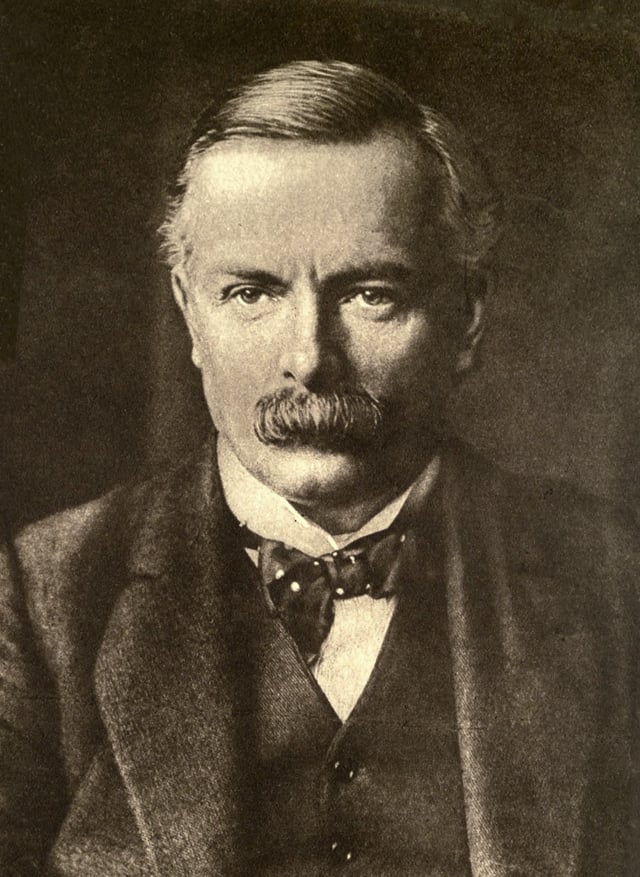
David Lloyd George in 1915
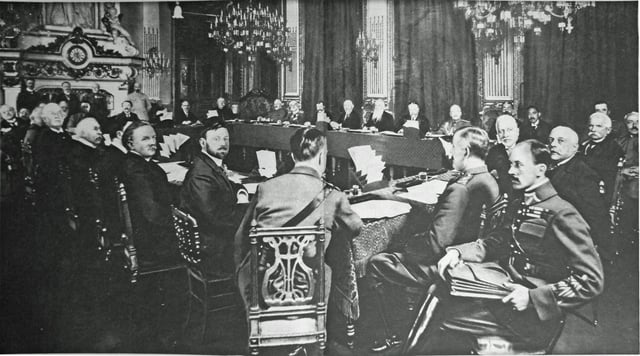
Lloyd George, Edward Grey, Herbert Kitchener, Nikola Pašić, Antonio Salandra, Alexander Izvolsky, Aristide Briand, Joseph Joffre at a conference of the Allied Powers on 27–28 March 1916 in Paris
Lloyd George gained a heroic reputation with his energetic work as Minister of Munitions, 1915–16, setting the stage for his move up to the height of power. After a long struggle with the War Office, he wrested responsibility for arms production away from the generals, making it a purely industrial department, with considerable expert assistance from Walter Runciman.[61] The two men gained the respect of Liberal cabinet colleagues for improving administrative capabilities, and increasing outputs.[62]
When the Shell Crisis of 1915 dismayed public opinion with the news that the Army was running short of artillery shells, demands rose for a strong leader to take charge of munitions. In the first coalition ministry, formed in May 1915, Lloyd George was made Minister of Munitions, heading a new department.[63] In this position he won great acclaim, which formed the basis for his political ascent. All historians agree that he boosted national morale and focussed attention on the urgent need for greater output, but many also say the increase in munitions output in 1915–16 was due largely to reforms already underway, though not yet effective, before he had even arrived. The Ministry broke through the cumbersome bureaucracy of the War Office, resolved labour problems, rationalised the supply system and dramatically increased production. Within a year it became the largest buyer, seller, and employer in Britain.[61]
Lloyd George was not at all satisfied with the progress of the war. He wanted to "knock away the props", by attacking Germany's allies – from early in 1915 he argued for the sending of British troops to the Balkans to assist Serbia and bring Greece and other Balkan countries onto the side of the Allies (this was eventually done – the Salonika expedition – although not on the scale that Lloyd George had wanted, and mountain ranges made his suggestions of grand Balkan offensives impractical); in 1916 he wanted to send machine guns to Romania (insufficient amounts were available for this to be feasible). These suggestions began a period of poor relations with the Chief of the Imperial General Staff, General Robertson, who was "brusque to the point of rudeness" and "barely concealed his contempt for Lloyd George's military opinions", to which he was in the habit of retorting "I've 'eard different".[64]
Lloyd George persuaded Kitchener, the Secretary of State for War, to raise a Welsh Division, and, despite Kitchener's threat of resignation, to recognise nonconformist chaplains in the Army.[65]
Late in 1915 Lloyd George became a strong supporter of general conscription, an issue that divided Liberals, and helped the passage of several conscription acts from January 1916 onwards. In spring 1916 Alfred Milner hoped Lloyd George could be persuaded to bring down the coalition government by resigning, but this did not happen.[66]
Secretary of State for War
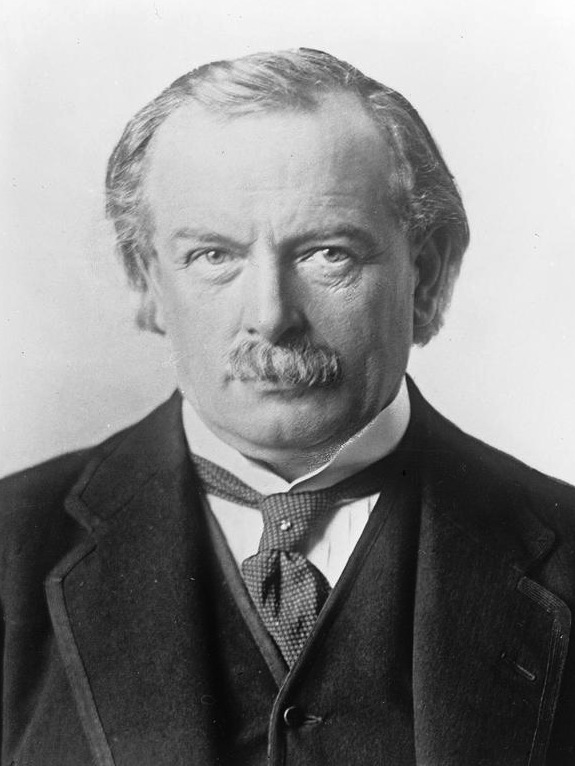
Lloyd George in 1916
In June 1916 Lloyd George succeeded Lord Kitchener (who died when his ship was sunk) as Secretary of State for War, although he had little control over strategy, as General Robertson had been given direct right of access to the Cabinet so as to bypass Kitchener. He did succeed in securing the appointment of Sir Eric Geddes to take charge of military railways behind British lines in France, with the honorary rank of major-general.[67] Lloyd George told a journalist, Roy W. Howard, in late September that "the fight must be to a finish – to a knockout", a rejection of President Woodrow Wilson's offer to mediate.[68]
Lloyd George was increasingly frustrated at the limited gains of the Somme Offensive, criticising General Haig to Ferdinand Foch on a visit to the Western Front in September (British casualty ratios were worse than those of the French, who were more experienced and had more artillery), proposing sending Robertson on a mission to Russia (he refused to go), and demanding that more troops be sent to Salonika to help Romania. Robertson eventually threatened to resign.[69]
Much of the press still argued that the professional leadership of Haig and Robertson was preferable to civilian interference which had led to disasters like Gallipoli and Kut. Lord Northcliffe, owner of The Times stormed into Lloyd George's office and, finding him unavailable, told his secretary "You can tell him that I hear he has been interfering with Strategy, and that if he goes on I will break him", and the same day (11 October) Lloyd George also received a warning letter from H. A. Gwynne, editor of the Morning Post. He was obliged to give his "word of honour" to Asquith that he had complete confidence in Haig and Robertson and thought them irreplaceable, but he wrote to Robertson wanting to know how their differences had been leaked to the press (affecting to believe that Robertson had not personally "authorised such a breach of confidence & discipline"). He asserted his right to express his opinions about strategy in November, by which time ministers had taken to holding meetings to which Robertson was not invited.[70]
The weakness of Asquith as a planner and organiser was increasingly apparent to senior officials. After Asquith had refused, then agreed, and then refused again to agree to Lloyd George's demand that he should be allowed to chair a small committee to manage the war, he resigned in December 1916. Grey was among leading Asquithians who had identified Lloyd George's intentions the previous month.[71] Lloyd George became Prime Minister, with the nation demanding he take vigorous charge of the war. A Punch cartoon of the time showed him as "The New Conductor" conducting the orchestra in the "Opening of the 1917 Overture".[72]
Although during the political crisis Robertson had advised Lloyd George to "stick to it" and form a small War Council, Lloyd George had planned if necessary to appeal to the country, his Military Secretary Colonel Arthur Lee having prepared a memo blaming Robertson and the General Staff for the loss of Serbia and Romania. Lloyd George was restricted by his promise to the Unionists to keep Haig as Commander-in-Chief and the press support for the generals, although Milner and Curzon were also sympathetic to campaigns to increase British power in the Middle East.[73] After Germany's offer (12 December 1916) of a negotiated peace Lloyd George rebuffed President Wilson's request for the belligerents to state their war aims by demanding terms tantamount to German defeat.[74]
Prime Minister (1916–1922)
War leader (1916–1918)
Forming a government
The fall of Asquith as Prime Minister split the Liberal Party into two factions: those who supported him and those who supported the coalition government. In his War Memoirs, Lloyd George compared himself with Asquith:[75]
There are certain indispensable qualities essential to the Chief Minister of the Crown in a great war. . . . Such a minister must have courage, composure, and judgment. All this Mr. Asquith possessed in a superlative degree. . . . But a war minister must also have vision, imagination and initiative—he must show untiring assiduity, must exercise constant oversight and supervision of every sphere of war activity, must possess driving force to energize this activity, must be in continuous consultation with experts, official and unofficial, as to the best means of utilising the resources of the country in conjunction with the Allies for the achievement of victory. If to this can be added a flair for conducting a great fight, then you have an ideal War Minister.
After December 1916 Lloyd George relied on the support of Conservatives and of the press baron Lord Northcliffe (who owned both The Times and the Daily Mail). Besides the Prime Minister, the five-member War Cabinet contained three Conservatives (Lord President of the Council and Leader of the House of Lords Lord Curzon, Chancellor of the Exchequer and Leader of the House of Commons Bonar Law, and Minister without Portfolio Lord Milner) and Arthur Henderson, unofficially representing Labour. Edward Carson was appointed First Lord of the Admiralty, as had been widely touted during the intrigues of the previous month, but excluded from the War Cabinet. Amongst the few Liberal frontbenchers to support Lloyd George were Christopher Addison (who had played an important role in drumming up some backbench Liberal support for Lloyd George), H. A. L. Fisher, Lord Rhondda and Sir Albert Stanley. Edwin Montagu and Churchill joined the government in the summer of 1917.[76]
Lloyd George wanted to make the destruction of Ottoman Empire a major British war aim, and two days after taking office told Robertson that he wanted a major victory, preferably the capture of Jerusalem, to impress British public opinion.[77]
At the Rome Conference (5–6 January 1917) Lloyd George was discreetly quiet about plans to take Jerusalem, an object which advanced British interests rather than doing much to win the war. Lloyd George proposed sending heavy guns to Italy with a view to defeating Austria-Hungary, possibly to be balanced by a transfer of Italian troops to Salonika, but was unable to obtain the support of the French or Italians, and Robertson talked of resigning.[78]
Nivelle Affair
Lloyd George engaged almost constantly in intrigues calculated to reduce the power of the generals, including trying to subordinate British forces in France to the French General Nivelle. He backed Nivelle because he thought he had 'proved himself to be a Man' by his successful counterattacks at Verdun, and because of his promises that he could break the German lines in 48 hours. Nivelle increasingly complained of Haig's dragging his feet rather than co-operating with their plans for the offensive.[79]
The plan was to put British forces under Nivelle's direct command for the great 1917 offensive. The British would attack first, thereby tying down the German reserves. Then the French would strike and score an overwhelming victory in two days. It was announced at a War Cabinet meeting on 24 February, to which neither Robertson nor Lord Derby (Secretary of State for War) had been invited. Ministers felt that the French generals and staff had shown themselves more skillful than the British in 1916, whilst politically Britain had to give wholehearted support to what would probably be the last major French effort of the war. The Nivelle proposal was then given to Robertson and Haig without warning on 26–27 February (minutes from the War Cabinet meeting were not sent to the King until 28 February, so that he did not have a prior chance to object). Robertson in particular protested vehemently. Finally a compromise was reached whereby Haig would be under Nivelle's orders but would retain operational control of British forces and keep a right of appeal to London "if he saw good reason". After further argument the status quo, that Haig was an ally of the French but was expected to defer to their wishes, was largely restored in mid-March.[80][81][82][83]
In the event the British attack at the Battle of Arras (9–14 April 1917) was partly successful but with much higher casualties than the Germans suffered. There had been many delays and the Germans, suspecting an attack, had shortened their lines to the strong Hindenburg Line. The French attack on the Aisne River in mid-April gained some tactically important high ground but failed to achieve the promised decisive breakthrough, pushing the French Army to the point of mutiny. While Haig gained prestige, Lloyd George lost credibility, and the affair further poisoned relations between himself and the "Brasshats".[84]
The U-Boat War
Shipping
In early 1917 the Germans had resumed unrestricted submarine warfare in a bid to achieve victory on the Western Approaches. Lloyd George set up a Ministry of Shipping under Sir Joseph Maclay, a Glasgow shipowner who was not, until after he left office, a member of either House of Parliament, and housed in a wooden building in a specially drained lake in St James's Park, within a few minutes' walk from the Admiralty. The Junior Minister and House of Commons spokesman was Leo Chiozza Money, with whom Maclay did not get on, but on whose appointment Lloyd George insisted, feeling that their qualities would complement one another. The Civil Service staff was headed by the highly able John Anderson (then only thirty-four years old) and included Arthur Salter. A number of shipping magnates were persuaded, like Maclay himself, to work unpaid for the ministry (as had a number of industrialists for the Ministry of Munitions), who were also able to obtain ideas privately from junior naval officers who were reluctant to argue with their superiors in meetings. The ministers heading the Board of Trade, for Munitions (Addison) and for Agriculture and Food (Lord Rhondda), were also expected to co-operate with Maclay.[85]
In accordance with a pledge Lloyd George gave in December 1916 nearly 90% of Britain's merchant shipping tonnage was soon brought under state control (previously less than half had been controlled by the Admiralty), whilst remaining privately owned (similar measures were in force at the time for the railways). Merchant shipping was concentrated, largely on Chiozza Money's initiative, on the transatlantic route where it could more easily be protected, instead of being spread out all over the globe (this relied on imports coming first into North America). Maclay began the process of increasing ship construction, although he was hampered by shortages of steel and labour, and ships under construction in the United States were confiscated by the Americans when she entered the war. In May 1917 Eric Geddes, based at the Admiralty, was put in charge of shipbuilding, and in July he became First Lord of the Admiralty.[86] Later the German U-Boats were defeated in 1918.
Convoys
Lloyd George had raised the matter of convoys at the War Committee in November 1916, only to be told by the admirals present, including Jellicoe, that convoys presented too large a target, and that merchant ship masters lacked the discipline to keep station in a convoy.[87]
In February 1917 Maurice Hankey, the secretary of the War Cabinet, wrote a memorandum for Lloyd George calling for the introduction of "scientifically organised convoys", almost certainly after being persuaded by Commander Reginald Henderson and the Shipping Ministry officials with whom he was in contact. After a breakfast meeting (13 February 1917) with Lloyd George, Sir Edward Carson (First Lord of the Admiralty) and Admirals Jellicoe and Duff agreed to "conduct experiments"; however, convoys were not in general use until August, by which time the rate of shipping losses was already in decline after peaking in April.[88]
Lloyd George later claimed in his War Memoirs that the delay in introducing convoys was because the Admiralty mishandled an experimental convoy between Britain and Norway, and because Jellicoe obtained, behind Maclay's back, an unrepresentative sample of merchant skippers claiming that they lacked the skill to "keep station" in convoy. In fact Hankey's diary shows that Lloyd George's interest in the matter was intermittent, whilst Frances Stevenson's diaries contain no mention of the topic. He may well have been reluctant, especially at a time when his relations with the generals were so poor, for a showdown with Carson, a weak administrator who was as much the mouthpiece of the admirals as Derby was of the generals, but who had played a key role in the fall of Asquith and who led a significant bloc of Conservative and Irish Unionist MPs.[89]
The new Commander of the Grand Fleet Admiral Beatty, whom Lloyd George visited at Invergordon on 15 April, was a supporter of convoys, as was the American Admiral Sims (the USA had just entered the war). The War Cabinet on 25 April authorised Lloyd George to look into the anti-submarine campaign, and on 30 April he visited the Admiralty. Duff had already recommended to Jellicoe that the Admiralty adopt convoys after a recent successful convoy from Gibraltar.[90]
Most of the organisations Lloyd George created during the First World War were replicated with the outbreak of the Second World War. As Lord Beaverbrook remarked, "There were no signposts to guide Lloyd George." The latter's personal efforts to promote convoys were less consistent than he (and Churchill in The World Crisis and Beaverbrook in Men and Power) later claimed; the idea that he, after a hard struggle, sat in the First Lord's chair (on his 30 April visit to the Admiralty) and imposed convoys on a hostile Board is a myth; however, in Grigg's view the credit goes largely to men and institutions which he set in place, and with a freer hand, and making fewer mistakes, than in his dealings with the generals, he and his appointees took decisions which can reasonably be said to have saved the country. "It was a close-run thing … failure would have been catastrophic."[91]
Russian Revolution
Lloyd George welcomed the Fall of the Tsar, both in a private letter to his brother and in a message to the new Russian Prime Minister Prince Lvov, not least as the war could now be portrayed as a clash between liberal governments and the autocratic Central Powers. Like many observers he had been taken by surprise by the exact timing of the revolution (it had not been predicted by Lord Milner or General Wilson on their visit to Russia a few weeks earlier) and hoped – albeit with some concerns – that Russia's war effort would be invigorated like that of France in the early 1790s.[92]
Lloyd George gave a cautious welcome to the suggestion (19 March on the western calendar) by the Russian Foreign Minister Pavel Milyukov that the toppled Tsar and his family be given sanctuary in Britain (although Lloyd George would have preferred that they go to a neutral country). From the very start the King's adviser Stamfordham raised objections, and in April the British government withdrew its consent under Royal pressure. Eventually the Russian Royal Family were moved to the Urals where they were executed in 1918. Lloyd George was often blamed for the refusal of asylum, and in his War Memoirs he did not mention King George V's role in the matter, which was not explicitly confirmed until Kenneth Rose's biography of the King was published in 1983.[93]
Imperial War Cabinet
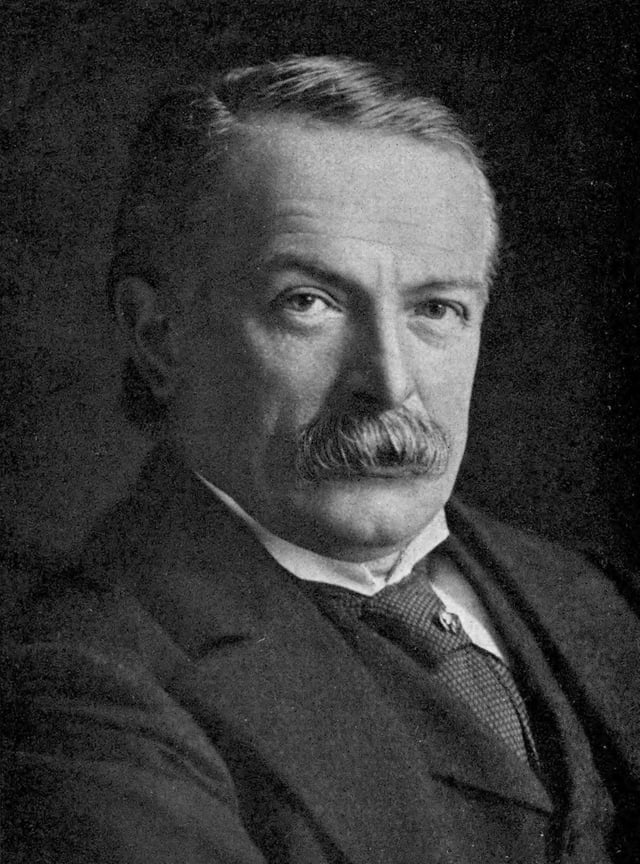
David Lloyd George circa 1918
An Imperial War Cabinet, including representatives from Canada, Newfoundland, Australia, New Zealand, South Africa and India, met in March–May 1917 (a crisis period of the war) and twice in 1918. The idea was not entirely without precedent as there had been Imperial Conferences in 1902, 1907 and 1911, whilst the Australian Prime Minister Billy Hughes had been invited to attend the Cabinet and War Committee on his visit to the UK in the spring of 1916. The South African Jan Smuts was appointed to the British War Cabinet in the early summer of 1917.[94]
Passchendaele
Lloyd George set up a War Policy Committee (himself, Curzon, Milner, Law and Smuts, with Maurice Hankey as secretary) to discuss strategy, which held 16 meetings over the next six weeks. At the very first meeting (11 June) Lloyd George proposed helping the Italians to capture Trieste,[95] explicitly telling the War Policy Committee (21 June 1917) that he wanted Italian soldiers to be killed rather than British.[96]
Haig believed that a Flanders Offensive had good chance of clearing the Belgian coast, from which German submarines and destroyers were operating (a popular goal with politicians), and that victory at Ypres "might quite possibly lead to (German) collapse". Robertson was less optimistic, but preferred Britain to keep her focus on defeating Germany on the Western Front, and had told Haig that the politicians would not "dare" overrule both soldiers if they gave the same advice. Haig promised he had no "intention of entering into a tremendous offensive involving heavy losses" (20 June) whilst Robertson wanted to avoid "disproportionate loss" (23 June).[97]
The Flanders Offensive was reluctantly sanctioned by the War Policy Committee on 18 July and the War Cabinet two days later, on condition it did not degenerate into a long drawn-out fight like the Somme. The War Cabinet promised to monitor progress and casualties and, if necessary call a halt, although in the event they made little effort to monitor progress until September. Frustrated at his inability to get his way, Lloyd George talked of resigning and taking his case to the public.[98]
The Battle of Passchendaele began on 31 July, but soon became bogged down in unseasonably early wet weather, which turned much of the battlefield into barely passable swamp in which men and animals sometimes drowned, whilst the mud and rain severely reduced the accuracy and effectiveness of artillery, the dominant weapon of the time. Lloyd George tried to enlist the King for diverting efforts against Austria-Hungary, telling Stamfordham (14 August) that the King and Prime Minister were "joint trustees of the nation" who had to avoid waste of manpower. A new Italian offensive began (18 August), but Robertson advised that it was "false strategy" to call off Passchendaele to send reinforcements to Italy, and despite being summoned to George Riddell's home in Sussex, where he was served apple pudding (his favourite dish), agreed only reluctantly. The Anglo-French leadership agreed in early September to send 100 heavy guns to Italy (50 of them French) rather than the 300 which Lloyd George wanted – Lloyd George talked of ordering a halt to Passchendaele, but in Hankey's words "funked it" (4 September). Had he not done so his government might have fallen, for as soon as the guns reached Italy Cadorna called off his offensive (21 September).[99]
At a meeting at Boulogne (25 September) Lloyd George broached with Painlevé the setting up of an Allied Supreme War Council then making Foch generalissimo.[100] Bonar Law had written to Lloyd George that ministers must soon decide whether or not the offensive was to continue. Lloyd George and Robertson met Haig in France (26 September) to discuss the recent German peace feelers (which in the end were publicly repudiated by Chancellor Michaelis)[101] and the progress of the offensive. Haig preferred to continue, encouraged by Plumer's recent successful attacks in dry weather at Menin Road (20 September) and Polygon Wood (26 September), and stating that the Germans were "very worn out". In October the wet weather returned for the final attack towards Passchendaele.[102] At the final meeting of the War Policy Committee on 11 October 1917, Lloyd George authorised the offensive to continue, but warning of failure in three weeks' time. Hankey (21 October) claimed in his diary that Lloyd George had deliberately allowed Passchendaele to continue in order to discredit Haig and Robertson and make it easier for him to forbid similar offensives in 1918.[103]
Supreme War Council
Lloyd George played a critical role in the Foreign Secretary Arthur Balfour's famous Declaration: "His Majesty's government view with favour the establishment in Palestine of a national home for the Jewish people, and will use their best endeavours to facilitate the achievement of this object, it being clearly understood that nothing shall be done which may prejudice the civil and religious rights of existing non-Jewish communities in Palestine, or the rights and political status enjoyed by Jews in any other country."
The Italians suffered disastrous defeat at Caporetto, requiring British and French reinforcements to be sent. Lloyd George said he "wanted to take advantage of Caporetto to gain "control of the War".[104] The Supreme War Council was inaugurated at the Rapallo Conference (6–7 November 1917). Lloyd George then gave a controversial speech at Paris (12 November) at which he criticised the high casualties of recent Allied "victories" (a word which he used with an element of sarcasm). These events led to an angry Commons debate (19 November), which Lloyd George survived.[105]
In reply to Robertson's 19 November memo, which warned (correctly) that the Germans would use the opportunity of Russia's departure from the war to attack in 1918 before the Americans were present in strength, Lloyd George wrote (wrongly) that the Germans would not attack and would fail if they did. That autumn he declared that he was willing "to risk his whole political reputation" to avoid a repetition of the Somme or Passchendaele.[106]
In December 1917 Lloyd George remarked to C. P. Scott that: "If people really knew, the war would be stopped tomorrow. But of course they don't know, and can't know."[107]
Manpower crisis and the unions
A Manpower Committee was set up on 6 December 1917, consisting of the Prime Minister, Curzon, Carson, George Barnes and Smuts with Maurice Hankey as secretary, and Auckland Geddes (Minister of National Service – in charge of Army recruitment) in regular attendance.[108]
The first meeting of the Manpower Committee was on 10 December, and it met twice the next day and again on 15 December. Lloyd George questioned Generals Macready (Adjutant-General) and Macdonogh (Chief of Military Intelligence), who advised that the Allied superiority of numbers on the Western Front would not survive the transfer of German reinforcements from the East now that Russia was dropping out of the war. Deeply concerned about the publicity attracted by the recent Lansdowne Letter's mention of casualties, he suggested removing Haig and Robertson from office at this time, but this was met by a threat of resignation from Lord Derby. At this stage Lloyd George opposed extending conscription to Ireland – Carson advised that extending conscription to Ulster alone would be impractical.[109]
When Hankey's report eventually emerged it reflected Lloyd George's wishes: it gave top priority to shipbuilding and merchant shipping (not least to ship US troops to Europe), and placed Army manpower below both weapons production and civilian industry. The size of the Army in Britain was to be reduced from eight divisions to four, freeing about 40,000 men for service in France.[110] In the House of Commons (20 December) Lloyd George also argued that the collapse of Russia and defeat of Italy required further "combing-out" of men from industry, in breach of pledges given to the trade unions in 1916. Auckland Geddes was given increased powers to direct labour – a new bill became law, despite the opposition of the Amalgamated Society of Engineers, in February 1918.[110]
The unions were placated with the Caxton Hall conference (5 January 1918), at which Lloyd George outlined Allied war aims. He called for Germany to be stripped of her conquests (including her colonies, and Alsace-Lorraine, annexed in 1871) and democratised (although he was clear that this was not an Allied war aim, but something which would help to ensure the future peace of Europe), and for the liberation of the subject peoples of Austria-Hungary and the Ottoman Empire. He also hinted at reparations (although it was suggested that these would not be on the scale imposed on France after 1871) and a new international order. Lloyd George explained to critics that he was hoping to detach Austria-Hungary and turn the German people against her rulers; the speech greatly increased his support amongst trade unions and the Labour Party.[111] President Wilson at first considered abandoning his speech outlining US war aims – the "Fourteen Points", many of which were similar to the aims outlined by Lloyd George – but was persuaded by his adviser Colonel House to deliver it. Wilson's speech (8 January) overshadowed Lloyd George's, and is better remembered by posterity.[112]
Strategic priorities
Lloyd George had told Edmund Allenby, who was appointed the new commander in Egypt in June, that his objective was "Jerusalem before Christmas" and that he had only to ask for reinforcements, although the exact nature of his offensives was still undecided when he was appointed. Amidst months of argument throughout the autumn of 1917 Robertson was able to block Lloyd George's plan to make Palestine the main theatre of operations by having Allenby make the impossible demand that thirteen extra divisions be sent to him.[113][114] Allenby captured Jerusalem in December 1917.
In the winter of 1917/18 Lloyd George secured the resignations of both the service chiefs. Removing the First Sea Lord Admiral Jellicoe earlier in 1917, as Lloyd George wanted, would have been politically impossible given Conservative anger at the return of Churchill (still blamed for the Dardanelles) to office as Minister of Munitions in July, and Lloyd George's preoccupations with Passchendaele, Caporetto and the Supreme War Council from July onward. By December it was clear that Lloyd George would have to sack Jellicoe or lose Eric Geddes (First Lord of the Admiralty), who wanted to return to his previous job in charge of military transport in France. The Christmas holiday, when Parliament was not sitting, provided a good opportunity. Before Jellicoe left for leave on Christmas Eve he received a letter from Geddes demanding his resignation. The other Sea Lords talked of resigning but did not do so, whilst Jellicoe's ally Carson remained a member of the War Cabinet until he resigned in January over Irish Home Rule.[115]
Relations with General Robertson had worsened further over the creation of the Supreme War Council at Versailles and he was eventually forced out over his insistence that the British delegate there be subordinate to Robertson as CIGS in London.[116]
Home Front
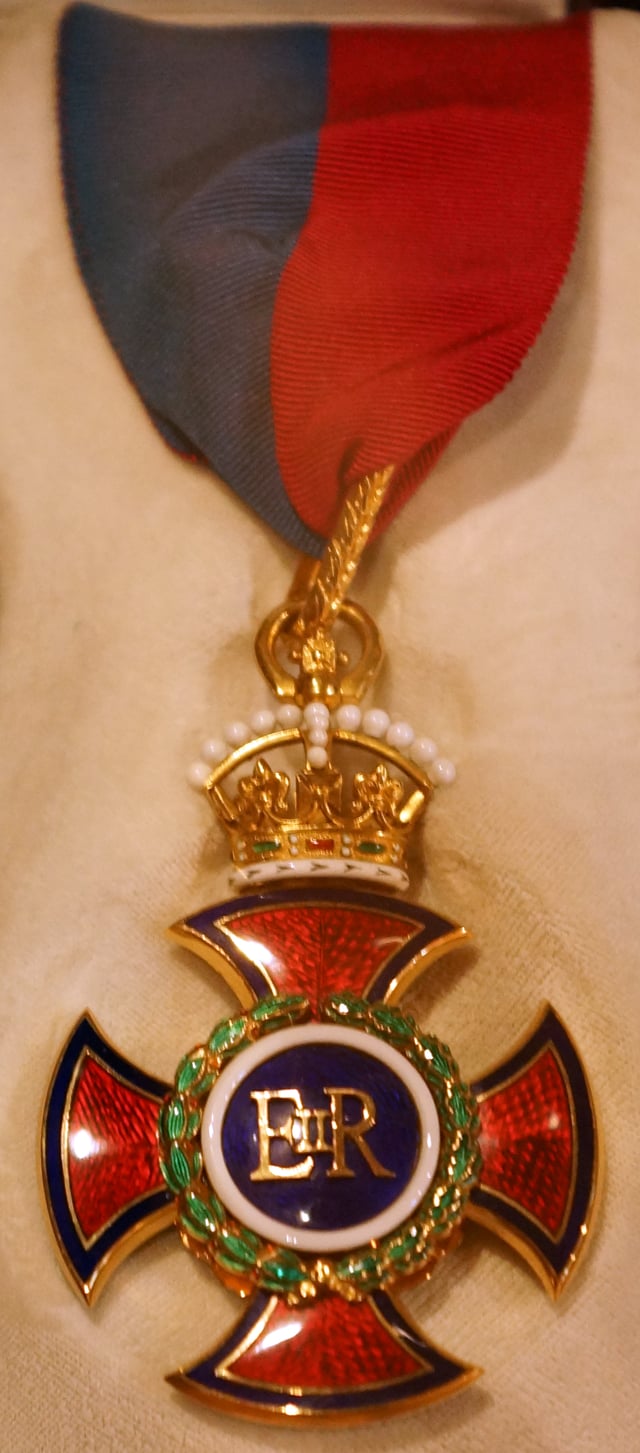
Order of Merit
The War Cabinet was a very successful innovation. It met almost daily, with Maurice Hankey as secretary, and made all major political, military, economic and diplomatic decisions. Rationing was finally imposed in early 1918 for meat, sugar and fats (butter and margarine) – but not bread; the new system worked smoothly. From 1914 to 1918 trade-union membership doubled, from a little over four million to a little over eight million. Work stoppages and strikes became frequent in 1917–18 as the unions expressed grievances regarding prices, alcohol control, pay disputes, dilution of labour, fatigue from overtime and from Sunday work, and inadequate housing.
The Corn Production Act 1917 bestowed upon the Board of Agriculture the power to ensure that all land was properly cultivated, appointed a wages board to operate a new minimum wage in agriculture, and guaranteed minimum prices for wheat and oats.[117]
Conscription put into uniform nearly every physically fit man, six million out of ten million eligible. Of these about 750,000 lost their lives and 1,700,000 were wounded. Most deaths were of young unmarried men; however, 160,000 wives lost their husbands and 300,000 children lost their fathers.[118]
Crises of 1918
In rapid succession in spring 1918 came a series of military and political crises.[119] The Germans, having moved troops from the Eastern front and retrained them in new tactics, now had more soldiers on the Western Front than the Allies. Germany launched the full scale Spring Offensive starting on 21 March against the British and French lines, hoping for victory on the battlefield before the American troops arrived in numbers. The Allied armies fell back 40 miles in confusion, and, facing defeat, London realised it needed more troops to fight a mobile war. Lloyd George found half a million soldiers and rushed them to France, asked American President Woodrow Wilson for immediate help, and agreed to the appointment of French General Foch as commander in chief on the Western Front. He considered taking on the role of War Minister himself, but was dissuaded by the king, and instead appointed Lord Milner.[120]
Despite strong warnings that it was a bad idea, the War Cabinet decided to impose conscription on Ireland. The main reason was that trade unions in Britain demanded it as the price for cutting back on conscription exemptions for certain workers. Labour wanted the principle established that no one was exempt, but it did not demand that conscription actually take place in Ireland. The proposal was enacted but never enforced. The Catholic bishops for the first time entered the fray and called for open resistance to conscription. Many Irish Catholics and nationalists moved into Sinn Féin, a decisive moment marking the dominance of Irish politics by a party committed to leaving the UK altogether.[121][122]
At one point Lloyd George unknowingly misled the House of Commons in claiming that Haig's forces were stronger at the start of 1918 than they had been a year earlier – in fact the increase was in the number of labourers, most of them Chinese, Indians and black South Africans, and Haig had fewer infantry, holding a longer stretch of front.[123] The prime minister had used incorrect information furnished by the War Department office headed by Major-General Sir Frederick Maurice. Maurice then made the spectacular public allegation that the War Cabinet had deliberately held soldiers back from the Western Front, and both Lloyd George and Bonar Law had lied to Parliament about it. Instead of going to the prime minister about the problem Maurice had waited and then broke King's Regulations by making a public attack. Asquith, still Liberal Party leader, took up the allegations and called for a Parliamentary Inquiry. While Asquith's presentation was poorly done, Lloyd George vigorously defended his position, treating the debate as a vote of confidence. He won over the House with a powerful refutation of Maurice's allegations. The Liberal Party was openly split for the first time.[124][125]
Meanwhile, the German offensive stalled. By summer the Americans were sending 10,000 fresh men a day to the Western Front, a speedup made possible by leaving their equipment behind and using British and French munitions. The German army had used up its last reserves and was steadily shrinking in numbers, further weakening its resolve. Victory came on 11 November 1918.[126]
That autumn Lloyd George was one of the many infected during the 1918 flu pandemic, but he survived.[127]
Postwar Prime Minister (1918–1922)
![Snowed underSt. Bernard Pup (to his Master). "This situation appeals to my hereditary instincts. Shall I come to the rescue?"[Before leaving Switzerland Mr. Lloyd George purchased a St. Bernard pup.]Cartoon from Punch 15 September 1920](https://everipedia.org/cdn-cgi/image/width=640/https://upload.wikimedia.org/wikipedia/commons/e/ec/David_Lloyd_George_-_Punch_cartoon_-_Project_Gutenberg_eText_17654.png)
Snowed underSt. Bernard Pup (to his Master). "This situation appeals to my hereditary instincts. Shall I come to the rescue?"[Before leaving Switzerland Mr. Lloyd George purchased a St. Bernard pup.]Cartoon from Punch 15 September 1920
At the end of the war Lloyd George's reputation stood at its zenith. Bonar Law, who was from a similar modest provincial background, said "He can be dictator for life if he wishes."[128] Headlines at this time declared a "huge majority win" and that "pacifists, even 'shining lights' such as Arnold Lupton, had been completely overthrown by Ramsay MacDonald and Philip Snowden".[129]
Coupon election of 1918
In the "Coupon election" of December 1918 he led a coalition of Conservatives and his own faction of Liberals to a landslide victory.[130] Coalition candidates received a "coalition coupon" (an endorsement letter signed by Lloyd George and Bonar Law). He did not say "We shall squeeze the German lemon until the pips squeak" (that was Sir Eric Geddes), but he did express that sentiment about reparations from Germany to pay the entire cost of the war, including pensions. He said that German industrial capacity "will go a pretty long way". We must have "the uttermost farthing", and "shall search their pockets for it".[131] As the campaign closed, he summarised his programme:[132]
Trial of the exiled Kaiser Wilhelm II;
Punishment of those guilty of atrocities;
Fullest indemnity from Germany;
Britain for the British, socially and industrially;
Rehabilitation of those broken in the war; and
A happier country for all.
The election was fought not so much on the peace issue and what to do with Germany, although those themes played a role. More important was the voters' evaluation of Lloyd George in terms of what he had accomplished so far and what he promised for the future. His supporters emphasised that he had won the Great War. Against his strong record in social legislation, he himself called for making "a country fit for heroes to live in".[133]
The Coalition gained an overwhelming victory, winning 525 of the 707 seats contested; however, the Conservatives had more than two-thirds of the Coalition's seats. Asquith's independent Liberals were crushed, although they were still the official opposition as the two Liberal factions combined had more seats than Labour.[134] Accounts vary about the factional allegiance of some MPs: by some accounts as few as 29 uncouponed Liberals had been elected, only 3 with any junior ministerial experience, and only 23 of them were actually opponents of the coalition. Until April 1919 the government whip was extended to all Liberal MPs and Lloyd George might easily have been elected chairman of the Liberal MPs (Asquith was still party leader but had lost his seat) had he been willing to antagonise his Conservative coalition partners by doing so.[135]
Paris 1919
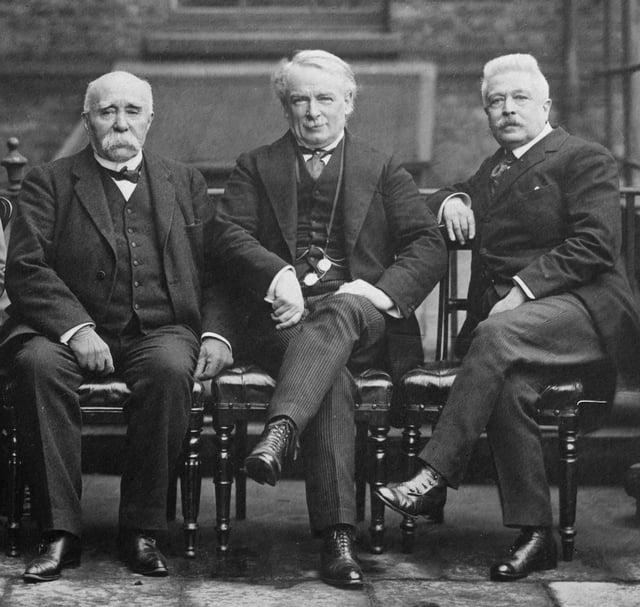
Georges Clemenceau, David Lloyd George and Vittorio Orlando at Paris
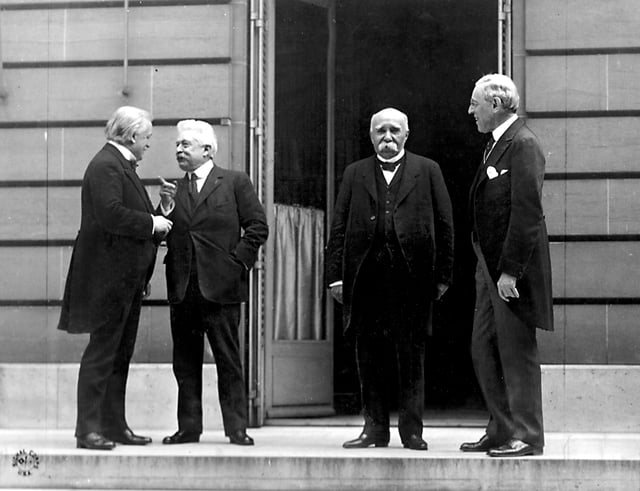
"The Big Four" made all the major decisions at the Paris Peace Conference (from left to right, Lloyd George, Vittorio Emanuele Orlando of Italy, Georges Clemenceau of France, Woodrow Wilson of the U.S.)
Lloyd George represented Britain at the Paris Peace Conference, clashing with the French Prime Minister, Georges Clemenceau, the US President, Woodrow Wilson, and the Italian Prime Minister, Vittorio Orlando.[136] Unlike Clemenceau and Orlando, Lloyd George on the whole stood on the side of generosity and moderation. He did not want to utterly destroy the German economy and political system—as Clemenceau demanded—with massive reparations. The economist John Maynard Keynes looked askance at Lloyd George's economic credentials in The Economic Consequences of the Peace, and in Essays in Biography called the Prime Minister a "goat-footed bard, half-human visitor to our age from the hag-ridden magic and enchanted woods of Celtic antiquity".[137]
Lloyd George was also responsible for the pro-German shift in the peace conditions regarding borders of Poland. Instead of handing over Upper Silesia (2,073,000 people), and the southern part of East Prussia (720,000 people) to Poland as was planned before, the plebiscite was organised. Danzig (366,000 people) was organised as Free City of Danzig. Poles were grateful that he had saved that country from the Bolsheviks but were annoyed by his comment that Poles were "children who gave trouble".[138] Asked how he had done at the peace conference, he commented, "I think I did as well as might be expected, seated as I was between Jesus Christ [Wilson] and Napoleon Bonaparte [Clemenceau]."[139]
Historian Antony Lentin evaluated his role in Paris as a major success. Unrivalled as a negotiator, Lloyd George had powerful combative instincts and indomitable determinism, and succeeded through charm, insight, resourcefulness, and simple pugnacity. Although sympathetic to France's desires to keep Germany under control, he did much to prevent the French from gaining power, attempted to extract Britain from the Anglo-French entente, inserted the war-guilt clause, and maintained a liberal and realist view of the postwar world. By doing so, he to consolidated power over the House of Commons, secured his power base, expanded the empire, and sought a European balance of power.[140]
Postwar social reforms
A major programme of social reform was introduced under Lloyd George in the last months of the war, and in the post-war years. The Workmen's Compensation (Silicosis) Act 1918 (which was introduced a year later) allowed for compensation to be paid to men "who could prove they had worked in rock which contained no less than 80% silica."[141] The Education Act 1918 raised the school leaving age to 14, increased the powers and duties of the Board of Education (together with the money it could provide to Local Education Authorities), and introduced a system of day-continuation schools which youths between the ages of 14 and 16 "could be compelled to attend for at least one day a week".[142] The Blind Persons Act 1920 provided assistance for unemployed blind people and blind persons who were in low paid employment.[143]
The Housing and Town Planning Act 1919 provided subsidies for house building by local authorities, and 170,000 dwellings were built under it by the end of 1922.[144] which established, according to A. J. P. Taylor, "the principle that housing was a social service".[145] A further 30,000 houses were constructed by private enterprise with government subsidy under a second act.[144] The Land Settlement (Facilities) Act 1919 and Land Settlement (Scotland) Acts of 1919 encouraged local authorities to provide land for people to take up farming "and also to provide allotments in urban areas."
Electoral changes: Suffragism
The Representation of the People Act 1918 greatly extended the franchise for men (by abolishing most property qualifications) and gave the vote to many women over 30, and the Parliament (Qualification of Women) Act 1918 enabled women to sit in the House of Commons. The Sex Disqualification (Removal) Act 1919 provided that "A person shall not be disqualified by sex or marriage from the exercise of any public function, or from being appointed to or holding any civil or judicial office or post, or from entering or assuming or carrying on any civil profession or vocation, or for admission to any incorporated society...".
Wages for Workers
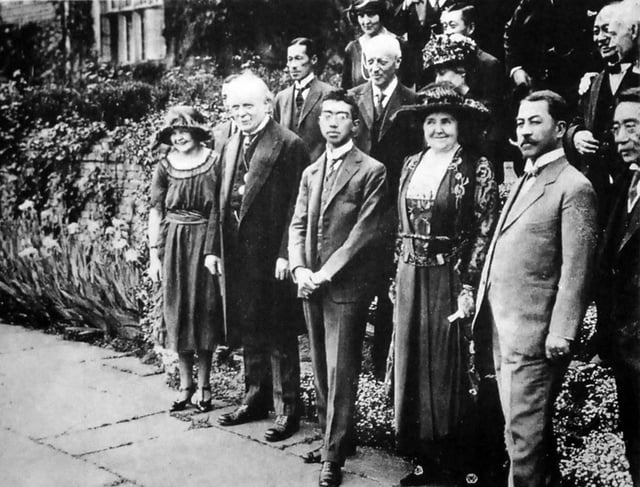
Lloyd George with Japanese Prince Hirohito, 1921
The Unemployment Insurance Act 1920 extended national insurance to 11 million additional workers. This was considered to be a revolutionary measure, in that it extended unemployment insurance to almost the entire labour force, whereas only certain categories of workers had been covered before.[148] As a result of this legislation, roughly three-quarters of the British workforce were now covered by unemployment insurance.[149]
The Agriculture Act 1920 provided for farm labourers to receive a minimum wage while the state continued to guarantee the prices of farm produce until 1921. It also provided tenant farmers with greater protection by granting them better security of tenure[150] In education, teachers' salaries were standardised, and more than doubled from pre-War levels, in 1921 by the Burnham Committee.[151]
Health for the Heroes
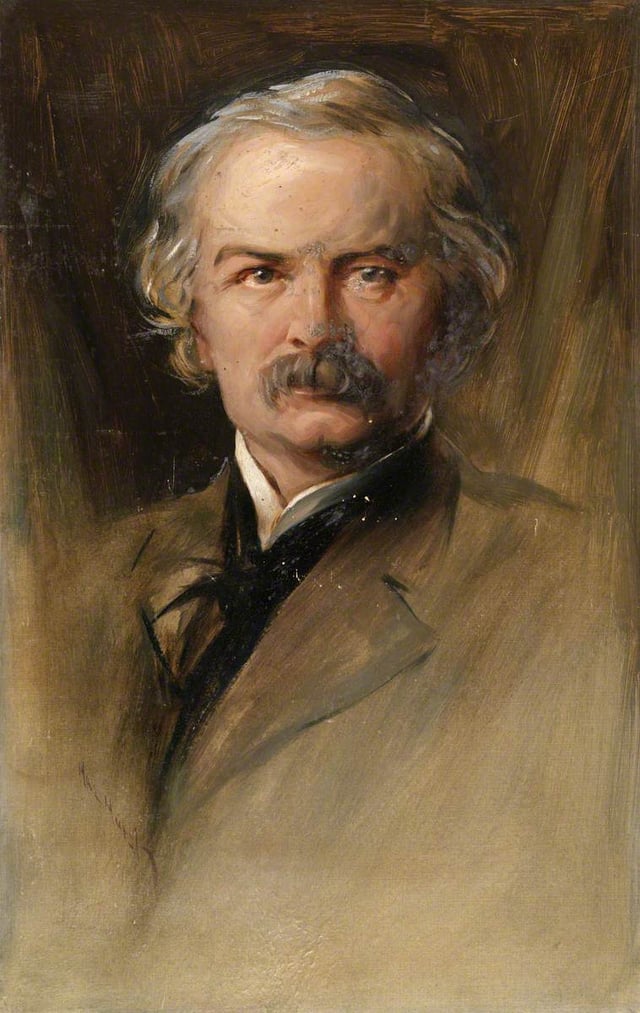
Portrait of David Lloyd George by Hal Hurst, 1915
In 1919, the government set up a Ministry of Health, a development which led to major improvements in public health in the years that followed.[148] whilst the Unemployed Workers' Dependants (Temporary Provisions) Act 1921 provided payments for the wives and dependent children of unemployed workers.[154] The Employment of Women, Young Persons, and Children Act 1920 prohibited the employment of children below the limit of compulsory school age in railways and transport undertakings, building and engineering construction works, factories, and mines. The legislation also prohibited the employment of children in ships at sea (except in certain circumstances, such as in respect of family members employed on the same vessel).[155]
The National Health Insurance Act 1920 increased insurance benefits, and eligibility for pensions was extended to more people. The means limit for pensions was raised by about two-thirds, aliens and their wives were allowed to receive pensions after living in Britain for ten years, and the imprisonment and "failure to work" disqualifications for receiving pensions were abolished. The Blind Persons Act 1920 reduced the pension age for blind people from 70 to 50.[156]
What was the cost?
The reforming efforts of the Coalition Government were such that, according to the historian Kenneth O. Morgan, its achievements were greater than those of the pre-war Liberal governments; however, the reform programme was substantially rolled back by the Geddes Axe, which cut public expenditure by £76 million, including substantial cuts to education,[158] and abolished the Agricultural Wages Board.[159]
Ireland
The armed insurrection by Irish republicans, known as the Easter Rising, took place in Dublin during Easter Week, 1916. The government responded with harsh repression; key leaders were quickly executed. The mostly Catholic Irish nationalists then underwent a dramatic change of mood, and shifted to demand vengeance and independence.[160][161] In 1917 Lloyd George called the 1917–18 Irish Convention in an attempt to settle the outstanding Home Rule for Ireland issue; however, the upsurge in republican sympathies in Ireland following the Easter Rising coupled with Lloyd George's disastrous attempt to extend conscription to Ireland in April 1918 led to the wipeout of the Irish Parliamentary Party at the December 1918 election.[162] Replaced by Sinn Féin MPs, they immediately declared an Irish Republic.
Lloyd George presided over the Government of Ireland Act 1920 which partitioned Ireland into Southern Ireland and Northern Ireland in May 1921 during the Anglo-Irish War. Lloyd George famously declared of the Irish Republican Army that "We have murder by the throat!"[163] However, he soon afterwards began negotiations with IRA leaders to recognise their authority and to end a bloody conflict. This culminated in the Anglo-Irish Treaty signed in December 1921 with Irish leaders. Under it Southern Ireland, representing over a fifth of the United Kingdom's territory, seceded in 1922 to form the Irish Free State.
Foreign policy crises
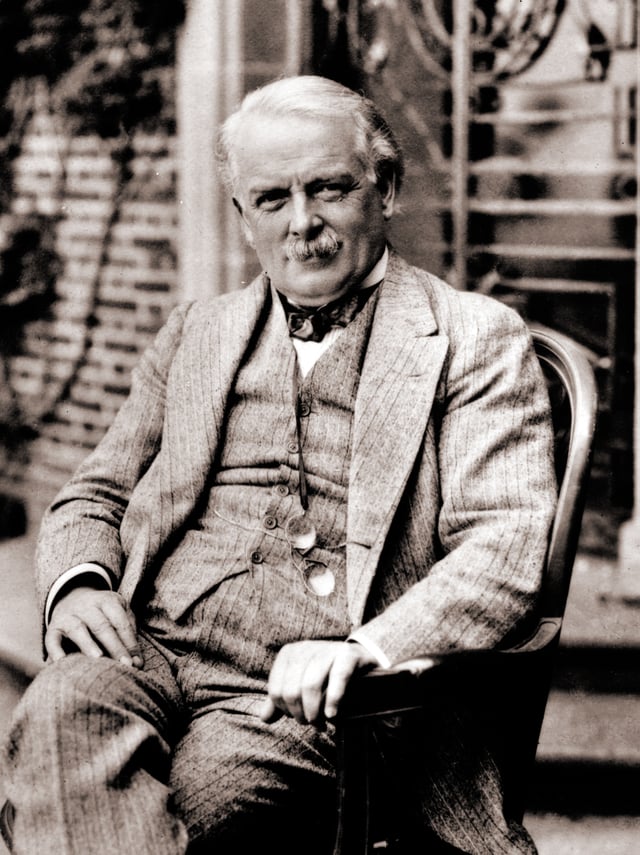
Lloyd George in 1922
A series of foreign policy crises gave Lloyd George his last opportunity to hold national and international leadership. Everything went wrong.[164] The League of Nations got off to a slow start and was largely ineffective. The Treaty of Versailles had set up a series of temporary organisations, composed of delegations from key powers, to ensure the successful application of the Treaty. The system worked poorly. The assembly of ambassadors was repeatedly overruled and became a nonentity. Most of the commissions were deeply divided and unable to either make decisions or convince the interested parties to carry them out. The most important commission was on Reparations, and France seized full control of it.[165] Raymond Poincaré, president of France, was intensely anti-German, was unrelenting in his demands for huge reparations, and was repeatedly challenged by Germany. France finally invaded western Germany, and Berlin responded by imposing a runaway inflation that seriously damaged the German economy and also damaged the French economy.[166] The United States, after refusing to ratify the League in 1920, almost completely disassociated itself from it. In 1921 the U.S. set up its own international programme for world disarmament that led to the successful Washington Naval Conference, leaving only a minor role for Britain. As the reparations crisis escalated, the United States seized control of it too, with the Dawes Plan of 1924 by which American banks loaned large sums to Germany, which paid reparations to the Allies, who in turn paid off their war loans to the United States.[167] In 1921 Lloyd George successfully concluded the Anglo-Soviet Trade Agreement. Despite much effort he was unable to negotiate full diplomatic relations, as the Russians rejected all repayment of Tsarist era debts, and Conservatives in Britain grew exceedingly wary of the communist threat to European stability. Indeed, Henry Wilson, the Chief of the Imperial General Staff, believed Lloyd George had become "a traitor & a Bolshevist".[168] Lloyd George in 1922 set about to make himself master of peace in the world, especially through the Genoa Conference that he expected would rival Paris of 1919 in visibility, and restore his reputation. Poincaré and the French demanded a military alliance that was far beyond what the British would accept. Germany and Russia made their own agreement at Rapallo which wrecked the Genoa conference.[169] Finally, Lloyd George decided to support Greece in a war against Turkey. This led to the Chanak Crisis when the Dominions, led by Canada and Australia, rejected the British policy and refused to support the proposed war. Internationally, and especially at home, Lloyd George the hero of the World War had suddenly become a failed model.[170]
Domestic crises
The more conservative wing of the Unionist Party had no intention of introducing reforms, which led to three years of frustrated fighting within the coalition both between the National Liberals and the Unionists and between factions within the Conservatives themselves. Many Conservatives were angered by the granting of independence to the Irish Free State and by Edwin Montagu's moves towards limited self-government for India, while a sharp economic downturn and wave of strikes in 1921 damaged Lloyd George's credibility. A scandal erupted in 1922 when it became known that Lloyd George had awarded honours and titles, such as baronetcies, to rich businessmen in return for cash in the range of £10,000 and more, via Maundy Gregory. A major attack on his corruption in the House of Lords followed, resulting in the Honours (Prevention of Abuses) Act 1925. The Conservatives also attacked Lloyd George as lacking any executive accountability as Prime Minister, claiming that he rarely appeared at Cabinet.[171] [172]
Fall from power 1922
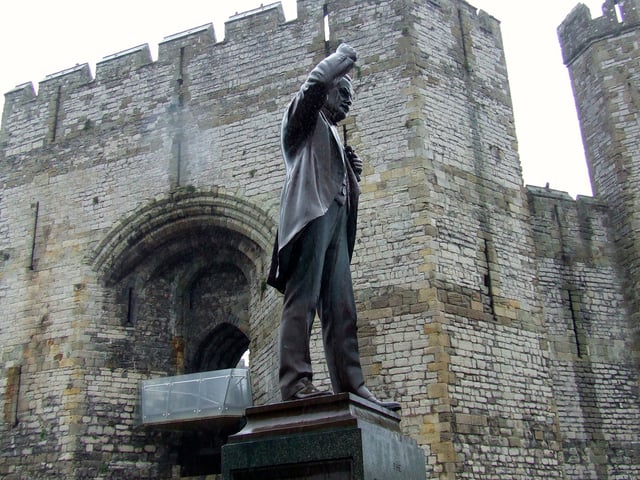
Lloyd George statue at Caernarfon Castle (1921), in recognition of his service as local MP and Prime Minister
The coalition was dealt its final blow in October 1922. The Conservatives felt let down by France over the Chanak Crisis, with Bonar Law telling France, "We cannot act alone as the policeman of the world."[173] The Conservative leader, Austen Chamberlain, summoned a meeting of Conservative Members of Parliament at the Carlton Club to discuss their attitude to the Coalition in the forthcoming election. Chamberlain and most Conservative leaders supported Lloyd George; however, the rank and file rejected the coalition. The main attack came from Stanley Baldwin, then President of the Board of Trade, who spoke of Lloyd George as a "dynamic force" who would break the Conservative Party. They sealed Lloyd George's fate on 19 October 1922 by voting in favour of the motion to end the coalition and fight the election "as an independent party, with its own leader and its own programme." Lloyd George submitted his resignation to the King that afternoon.[174][175]
Later political career (1922–1945)
Liberal reunion
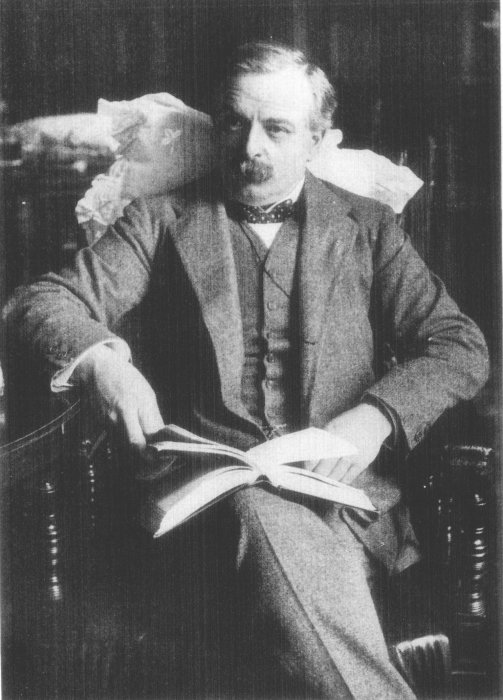
David Lloyd George
Throughout the 1920s Lloyd George remained highly visible in politics; predictions that he would return to power were common, but it never happened.[176] He still controlled a large fund (thought to have been between £1m and £3m, or £50m–£150m at 2015 prices) from his investments in newspaper ownership and from his sale of titles.[177][178]
Before the 1923 election, he resolved his dispute with Asquith, allowing the Liberals to run a united ticket against Stanley Baldwin's policy of protective tariffs. Baldwin both feared and despised Lloyd George, and one of his aims was to keep him out of power. He later claimed that he had adopted tariffs, which cost the Conservatives their majority, out of concern that Lloyd George was about to do so on his return from a tour of North America. Although there was press speculation at the time that Lloyd George would do so (or adopt US-style Prohibition to appeal to newly enfranchised women voters), there is no evidence that this was his intent.[179] Asquith and Lloyd George reached agreement on 13 November 1923 and issued a joint Free Trade manifesto, followed by a more general one. Lloyd George agreed to contribute £100,000 (in the event he claimed to have contributed £160,000 including help given to individual candidates; Liberal HQ put the number at £90,000).[180]
In 1924 Lloyd George, realising that Liberal defeat was inevitable and keen to take control of the party himself, spent only £60,000.[181] At the 1924 general election, Baldwin won a clear victory, the leading coalitionists such as Austen Chamberlain and Lord Birkenhead (and former Liberal Winston Churchill) agreeing to serve under Baldwin and thus ruling out any restoration of the 1916–22 coalition.
Liberal leader
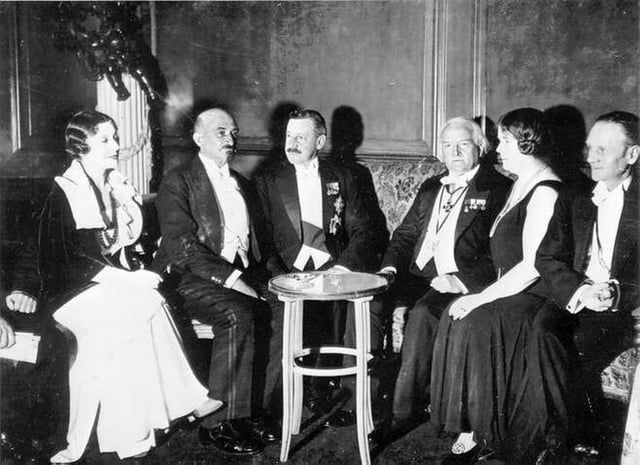
Vera Weizmann, Chaim Weizmann, Herbert Samuel, Lloyd George, Ethel Snowden, and Philip Snowden
The disastrous election result in 1924 left the Liberals as a weak third party in British politics, with just over 40 MPs. Although Asquith, who had again lost his seat and was created an Earl, remained Liberal leader, Lloyd George was elected chairman of the Liberal MPs by 26 votes to 7. Sir John Simon and his followers were still loyal to Asquith (after 1931 Simon would lead a breakaway National Liberal Party, which eventually merged with the Conservatives) whilst Walter Runciman led a separate radical group within the Parliamentary Party.[182]
Lloyd George was now mainly interested in the reform of land ownership, but had only been permitted to put a brief paragraph about it in the hastily drafted 1924 Liberal manifesto. In the autumn of 1925, despite the hostility of Charles Hobhouse, Runciman and Alfred Mond, he began an independent campaign, soon to become “The Land and the Nation” (the "Green Book", first of a series of policy pamphlets produced by Lloyd George in the late 1920s). Asquith rebuked him, but was ignored, and they reached an agreement in principle on 2 December, then together they presented Lloyd George's plans to the National Liberal Federation on 26 February 1926.[183][184]
The Liberal Shadow Cabinet, including Lloyd George, unequivocally backed Baldwin's handling of the General Strike on 3 May, but Lloyd George then wrote an article for the American press more sympathetic to the strikers, and did not attend the Shadow Cabinet on 10 May, sending his apologies on “policy grounds”. Asquith sent him a public letter (20 May) rebuking him for not attending the meeting to discuss his opinions with colleagues in private. Lloyd George's letter of 10 May had not been published, making it appear that Asquith had fired the first shot, and Lloyd George sent a public reply, moderate in tone (the journalist C. P. Scott helped him draft it), on 25 May. In late May, the executive of the National Liberal Federation convened to plan the agenda for the following month's conference. 16 were pro Asquith and 8 pro Lloyd George; they planned a motion expressing confidence in Asquith, but another option was also proposed to seek Asquith's opinion first, and also general feeling of regret at having been forced to choose between Asquith and Lloyd George. Asquith then wrote another public letter (1 June) stating that he regarded Lloyd George's behaviour as tantamount to resignation, the same as if a Cabinet Minister had refused to abide by the principle of collective responsibility. Twelve leading Liberals wrote in Asquith's support to “The Times” (1 June); however, Lloyd George had more support in the wider party than among the grandees: the London Liberal Candidates’ Association (3 June) defied its officers and expressed its dismay at the split, effectively supporting Lloyd George, and on 8 June the Liberal MPs voted 20:10 urging a reconciliation. Asquith had planned to launch a fightback at the National Liberal Federation in Weston-Super-Mare, but on 12 June, five days before the conference was due to start, he suffered a stroke which put him out of action for three months. Lloyd George was given a rapturous welcome. Asquith resigned as party leader in October, dying in 1928.[185][186]
As Liberal leader at last, Lloyd George used his fund to finance candidates and put forward innovative ideas for public works to reduce unemployment (as detailed in pamphlets such as the "Yellow Book" and the "Orange Book"). Charles Masterman later wrote: "When Lloyd George came back to the party, ideas came back to the party".[187] Lloyd George was also helped by John Maynard Keynes to write We can Conquer Unemployment, setting out economic policies to solve unemployment. In 1927 Lloyd George gave £300,000 plus an annual grant of between £30,000 and £40,000 for the operations of the Liberal headquarters. He also gave £2,000 per annum to the parliamentary party until 1931.[188][189] Even with the money the results at the 1929 general election were disappointing. The Liberals increased their support only to 60 or so seats, while Labour became the largest party for the first time. Once again, the Liberals ended up supporting a minority Labour government. In 1929 Lloyd George became Father of the House (longest-serving member of the Commons), an honorific position without power.
Marginalised
In 1931 an illness prevented his joining the National Government when it was formed. Later when the National Government called a General Election he tried to pull the Liberal Party out of it but succeeded in taking only a few followers, most of whom were related to him; the main Liberal Party remained in the coalition for a year longer, under the leadership of Sir Herbert Samuel. By the 1930s Lloyd George was on the margins of British politics, although still intermittently in the public eye and publishing his War Memoirs. Lloyd George was President of the London Welsh Trust, which runs the London Welsh Centre, Gray's Inn Road, from 1934 until 1935.[190]
Lloyd George's "New Deal"
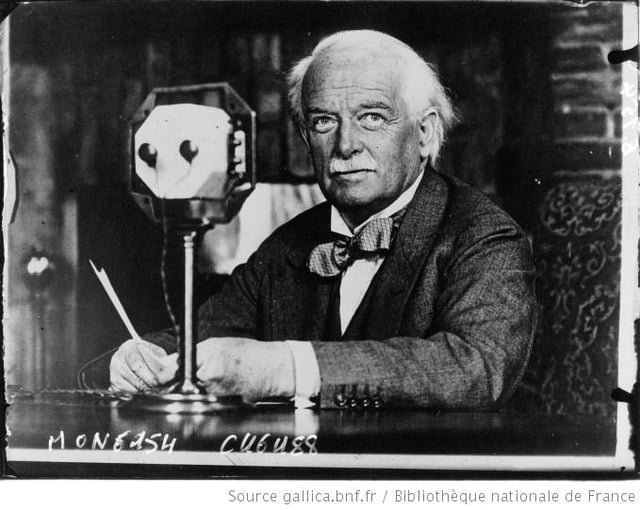
Lloyd George in 1932
In January 1935 Lloyd George announced a programme of economic reform, called "Lloyd George's New Deal" after the American New Deal. This Keynesian economic programme was essentially the same as that of 1929. MacDonald requested that he put his case before the Cabinet, and so in March Lloyd George submitted a 100-page memorandum that was cross-examined between April and June in ten meetings of the Cabinet's sub-committee; however, the programme did not find favour; two-thirds of Conservative MPs were against Lloyd George's joining the National government, and some Cabinet members would have resigned if he had joined.[191]
Appeasement of Germany
Lloyd George was consistently pro-German after 1923.[192] He supported German demands for territorial concessions and recognition of its "great power" status; he paid much less attention to the security concerns of France, Poland, Czechoslovakia and Belgium.[193] In a speech in 1933 he warned that if Adolf Hitler were overthrown Communism would replace him in Germany.[194] In August 1934 (following Austria's transition to fascism), he insisted Germany could not wage war, and assured European nations that there would be no risk of war during the next ten years.[195] In September 1936, he went to Germany to talk with Hitler. Hitler said he was pleased to have met "the man who won the war"; Lloyd George was moved, and called Hitler "the greatest living German".[196] Lloyd George also visited Germany's public works programmes and was impressed. On his return to Britain, he wrote an article for the Daily Express praising Hitler, stating: "The Germans have definitely made up their minds never to quarrel with us again."[197] He believed Hitler was "the George Washington of Germany"; that he was rearming Germany for defence and not for offensive war; that a war between Germany and the Soviet Union would not happen for at least ten years; that Hitler admired the British and wanted their friendship but that there was no British leadership to exploit this; however, by 1937, Lloyd George's distaste for Neville Chamberlain led him to disavow Chamberlain's appeasement policies.[197][198]
Final years
In the last important parliamentary intervention of his career, which occurred during the crucial Norway Debate of May 1940, Lloyd George made a powerful speech that helped to undermine Chamberlain as Prime Minister and to pave the way for the ascendancy of Churchill. Churchill offered Lloyd George the agriculture portfolio in his Cabinet but he refused, citing his unwillingness to sit alongside Chamberlain. Lloyd George also thought that Britain's chances in the war were dim, and he remarked to his secretary: "I shall wait until Winston is bust."[199] He wrote to the Duke of Bedford in September 1940, during the Battle of Britain, advocating a negotiated peace with Germany.[200]
A pessimistic speech by Lloyd George on 7 May 1941 led Churchill to compare him with Philippe Pétain. On 11 June 1942, he made his last speech in the House of Commons, and he cast his last vote in the Commons on 18 February 1943 as one of the 121 MPs (97 Labour) condemning the Government for its failure to back the Beveridge Report. Fittingly, his final vote was in defence of the welfare state which he had helped to create.[201]
Although he had displayed political courage all his life, in his last years he gave way to physical timidity and hypochondria. He continued to attend Castle Street Baptist Chapel in London, and to preside over the National Eisteddfod at its Thursday session each summer. In September 1944, he and Frances left his home, Bron-y-de in Churt, for Tŷ Newydd, a farm near his boyhood home in Llanystumdwy. He was now weakening rapidly and his voice failing. He was still an MP but had learned that wartime changes in the constituency meant that Carnarvon Boroughs might go Conservative at the next election. On New Years Day 1945, Lloyd George was raised to the peerage as Earl Lloyd-George of Dwyfor, and Viscount Gwynedd, of Dwyfor in the County of Caernarvonshire; however, he did not live long enough to take his seat in the House of Lords [202]
Death
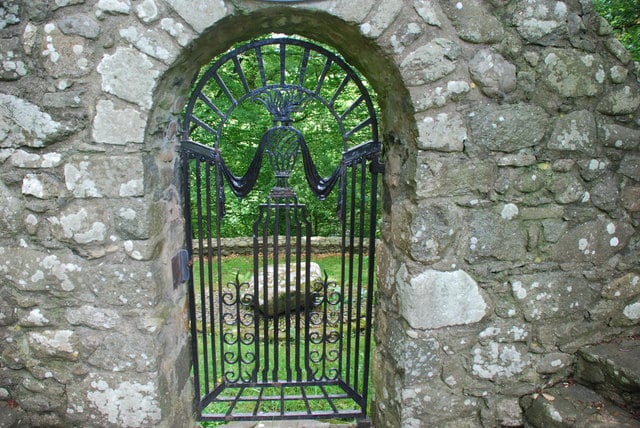
Lloyd George's grave, Llanystumdwy
Lloyd George died of cancer at the age of 82 on 26 March 1945, with his wife Frances and his daughter Megan at his bedside. Four days later, on Good Friday, he was buried beside the river Dwyfor in Llanystumdwy.[203] A boulder marks the grave; there is no inscription; however a monument designed by the architect Sir Clough Williams-Ellis was subsequently erected around the grave,[204] bearing an englyn (strict-metre stanza) engraved on slate in his memory composed by his nephew Dr W. R. P. George. Nearby stands the Lloyd George Museum, also designed by Williams-Ellis and opened in 1963.
Assessment
Historian Martin Pugh in The Oxford Companion to British History argues that he:
made a greater impact on British public life than any other 20th-cent. statesman. He laid the foundations of what later became the welfare state, and put a progressive income tax system at the centre of government finance. He also left his mark on the system of government by enlarging the scope of the prime minister's role. He was acclaimed, not without reason, as the 'Man Who Won the War'....he was blamed by many Liberals for destroying their party in 1918, hated in the Labour movement for his handling of industrial issues after 1918, and disparaged by Conservatives for his radicalism.[205]
George Riddell, 1st Baron Riddell, a wealthy newspaper publisher, was a close confidant and financial supporter of Lloyd George from 1908 to 1922, and Riddell's revealing diary is a valuable source for the period.[206] During Lloyd George's first year as prime minister, in summer 1917, Riddell assessed his personality:
His energy, capacity for work, and power of recuperation are remarkable. He has an extraordinary memory, imagination, and the art of getting at the root of a matter....He is not afraid of responsibility, and has no respect for tradition or convention. He is always ready to examine, scrap or revise established theories and practices. These qualities give him unlimited confidence in himself.... He is one of the craftiest of men, and his extraordinary charm of manner not only wins him friends, but does much to soften the asperities of his opponents and enemies. He is full of humour and a born actor....He has an instinctive power of divining the thoughts and intentions of people with whom he is conversing...His chief defects are: (1) Lack of appreciation of existing institutions, organisations, and stolid, dull people...their ways are not his ways and their methods are not his methods. (2) Fondness for a grandiose scheme in preference to an attempt to improve existing machinery. (3) Disregard of difficulties in carrying out big projects...he is not a man of detail.[207]
Historian John Shepherd wrote in History Today:
In any poll of modern historians Winston Churchill and David Lloyd George would emerge as the two most renowned prime ministers during the past century.[208]
Family
Margaret and children
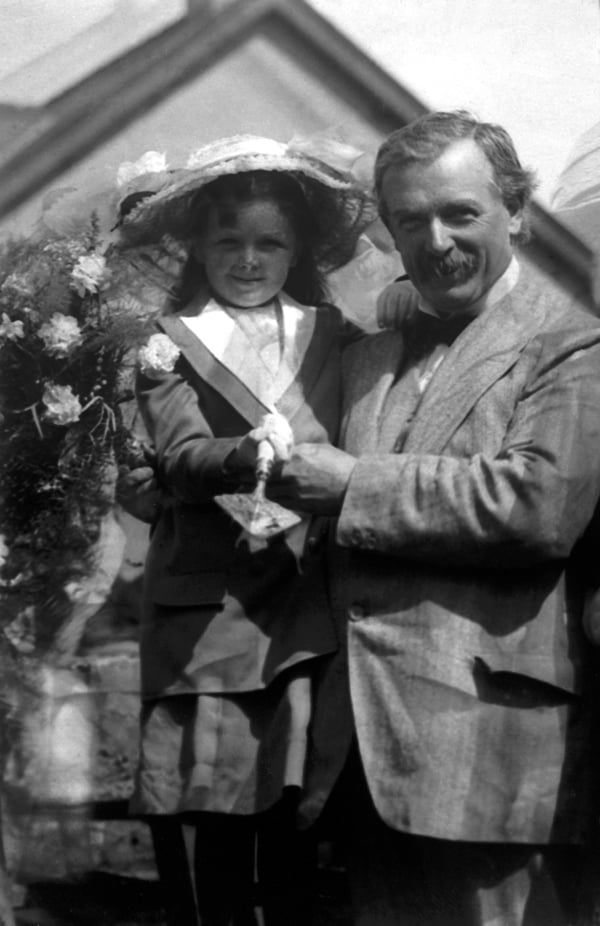
David Lloyd George with his daughter Megan in 1911
He had five children by his first wife, Margaret: Richard (1889–1968), Mair (1890–1907, who died during an appendectomy), Olwen (1892–1990), Gwilym (1894–1967) and Megan (1902–1966). He remained married to Margaret, and remained fond of her until her death[209] on 20 January 1941; Lloyd George was deeply upset by the fact that bad weather prevented him from being with her when she died.
His son, Gwilym, and his daughter, Megan, both followed him into politics, and were elected members of parliament. They were politically faithful to their father throughout his life, but after 1945 each drifted away from the Liberal Party, Gwilym finishing his career as a Conservative Home Secretary and Megan becoming a Labour MP in 1957.
Frances
In October 1943, aged 80, and to the disapproval of his children,[210] he married his secretary and mistress, Frances Stevenson. He had first met Stevenson in 1910, and she had worked for him first as a teacher for Megan in 1911;[211] their affair began in early 1913.[212] Lloyd George may well have been the father of Stevenson's daughter Jennifer (1929–2012), born long before they wed.[213]
Frances was the first Countess Lloyd-George, and is now largely remembered for her diaries, which dealt with the great issues, and statesmen, of Lloyd George's heyday. A volume of their letters, My Darling Pussy, has also been published; Lloyd George's nickname for Frances referred to her gentle personality.[214]
Descendants
The Canadian historian Margaret MacMillan, who detailed Lloyd George's role at the 1919 Peace Conference in her book, Peacemakers, is his great-granddaughter. The British television historian and presenter Dan Snow is a great-great-grandson.[215] Other descendants include the late Owen, 3rd Earl Lloyd-George, his grandson, and the late 3rd Earl's younger son The Hon. Robert Lloyd George (Chairman of Lloyd George Management),[216] brother of David, the 4th and present Earl, who has two sons: Viscount Gwynedd (born 1986), a journalist, and Captain the Hon. Fred Lloyd George, an officer in the Welsh Guards (born 1987).
Lloyd George's Cabinets
War Cabinet
Lord Curzon of Kedleston – Lord President of the Council and Leader of the House of Lords
Bonar Law – Chancellor of the Exchequer and Leader of the House of Commons
Arthur Henderson – Minister without Portfolio
Lord Milner – Minister without Portfolio
War Cabinet changes
May–August 1917 – In temporary absence of Arthur Henderson, George Barnes, Minister of Pensions, acts as a member of the War Cabinet.
June 1917 – Jan Smuts enters the War Cabinet as a Minister without Portfolio
July 1917 – Sir Edward Carson enters the War Cabinet as a Minister without Portfolio
August 1917 – George Barnes succeeds Arthur Henderson (resigned) as Minister without Portfolio and Labour Party member of the War Cabinet.
January 1918 – Carson resigns and is not replaced
April 1918 – Austen Chamberlain succeeds Lord Milner as Minister without Portfolio.
January 1919 Law becomes Lord Privy Seal, remaining Leader of the House of Commons, and is succeeded as Chancellor of the Exchequer by Chamberlain; both remaining in the War Cabinet. Smuts is succeeded by Sir Eric Geddes as Minister without Portfolio.
Other members of Lloyd George's War Government
Lord Finlay – Lord Chancellor
Lord Crawford – Lord Privy Seal
Sir George Cave – Secretary of State for the Home Department
Arthur Balfour – Secretary of State for Foreign Affairs
Walter Long – Secretary of State for the Colonies
Lord Derby, and then (after April 1918), Lord Milner – Secretary of State for War
Austen Chamberlain (to 1917), and then Edwin Montagu – Secretary of State for India
Sir Edward Carson, and then (from 1917) Sir Eric Geddes – First Lord of the Admiralty
Sir Frederick Cawley (to 1918), and then Lord Beaverbrook and Lord Downham – Chancellor of the Duchy of Lancaster
Sir Albert Stanley – President of the Board of Trade
H. E. Duke and then Edward Shortt – Chief Secretary for Ireland
Hayes Fisher – President of the Local Government Board (to 1918)
Sir Auckland Geddes – President of the Local Government Board (to 1919)
Winston Churchill – Minister of Munitions (appointed 17/7/17)
Neville Chamberlain, and then (from 1917) Sir Auckland Geddes – Director of National Service
Peacetime Government, January 1919 – October 1922
The War Cabinet was formally maintained for much of 1919, but as Lloyd George was out of the country for many months this made little difference. In October 1919 a formal Cabinet was reinstated.
David Lloyd George — Prime Minister
Lord Birkenhead – Lord Chancellor
Lord Curzon of Kedleston – Lord President of the Council and Leader of the House of Lords
Bonar Law – Lord Privy Seal and Leader of the House of Commons
Austen Chamberlain – Chancellor of the Exchequer
Edward Shortt – Secretary of State for the Home Department
Arthur Balfour – Secretary of State for Foreign Affairs
Lord Milner – Secretary of State for the Colonies
Winston Churchill – Secretary of State for War and Air
Edwin Montagu – Secretary of State for India
Walter Long – First Lord of the Admiralty
Sir Albert Stanley – President of the Board of Trade
Robert Munro – Secretary for Scotland
Ian Macpherson – Chief Secretary for Ireland
Lord French – Lord-Lieutenant of Ireland
Christopher Addison – President of the Local Government Board
Rowland Prothero – President of the Board of Agriculture
H. A. L. Fisher – President of the Board of Education
Lord Inverforth – Minister of Munitions
Sir Robert Horne – Minister of Labour
George Barnes – Minister without Portfolio
Sir Eric Geddes – Minister without Portfolio
Peacetime changes
May 1919 – Sir Auckland Geddes succeeds Sir Albert Stanley as President of the Board of Trade. Sir Eric Geddes becomes Minister of Transport.
October 1919 – Lord Curzon of Kedleston succeeds Balfour as Foreign Secretary. Balfour succeeds Curzon as Lord President. The Local Government Board is abolished. Christopher Addison becomes Minister of Health. The Board of Agriculture is abolished. Lord Lee of Fareham becomes Minister of Agriculture. Sir Eric Geddes becomes Minister of Transport.
January 1920 – George Barnes leaves the cabinet.
March 1920 – Sir Robert Horne succeeds Sir Auckland Geddes as President of the Board of Trade. Thomas Macnamara succeeds Horne as Minister of Labour.
April 1920 – Sir Hamar Greenwood succeeds Ian Macpherson as Chief Secretary for Ireland. Sir Laming Worthington-Evans joins the Cabinet as Minister without Portfolio.
February 1921 – Winston Churchill succeeds Lord Milner as Colonial Secretary. Sir Laming Worthington-Evans succeeds Churchill as War Secretary. Freddie Guest, Churchill's successor as Air Secretary, was not in the Cabinet. Lord Lee of Fareham succeeds Walter Long at the Admiralty. Sir Arthur Griffith-Boscawen succeeds Lee as Minister of Agriculture.
March 1921 – Austen Chamberlain succeeds Bonar Law as Lord Privy Seal and Leader of the Commons. Sir Robert Horne succeeds Chamberlain at the Exchequer. Stanley Baldwin succeeds Horne at the Board of Trade.
April 1921 – Lord French resigns from the cabinet, remaining Lord Lieutenant of Ireland. Christopher Addison becomes a Minister without Portfolio. Sir Alfred Mond succeeds him as Minister of Health. The Ministry of Munitions is abolished.
November 1921 – Sir Eric Geddes resigns from the cabinet. His successor as Minister of Transport, Viscount Peel, is not in the Cabinet. The Attorney General, Sir Gordon Hewart, enters the Cabinet.
March 1922 – Lord Peel succeeds Edwin Montagu as India Secretary.
April 1922 – The First Commissioner of Works, Lord Crawford, enters the Cabinet.
Styles of address and honours
Styles of address
1863–1890: Mr David Lloyd George
1890–1906: Mr David Lloyd George MP
1906–1919: The Rt Hon David Lloyd George MP
1919–1945: The Rt Hon David Lloyd George OM MP
1945: The Rt Hon The Earl Lloyd-George of Dwyfor OM PC
Peerage
[[INLINE_IMAGE|//upload.wikimedia.org/wikipedia/commons/thumb/f/f1/Coronet_of_a_British_Earl.svg/30px-Coronet_of_a_British_Earl.svg.png|//upload.wikimedia.org/wikipedia/commons/thumb/f/f1/Coronet_of_a_British_Earl.svg/45px-Coronet_of_a_British_Earl.svg.png 1.5x, //upload.wikimedia.org/wikipedia/commons/thumb/f/f1/Coronet_of_a_British_Earl.svg/60px-Coronet_of_a_British_Earl.svg.png 2x|Coronet of a British Earl.svg|h23|w30]] Earl Lloyd-George of Dwyfor, Viscount Gwynedd, of Dwyfor in the county of Caernarvonshire (created 12 February 1945).
Decorations
[[INLINE_IMAGE|//upload.wikimedia.org/wikipedia/commons/thumb/3/3a/Order_of_Merit_%28Commonwealth_realms%29_ribbon.png/60px-Order_of_Merit_%28Commonwealth_realms%29_ribbon.png|//upload.wikimedia.org/wikipedia/commons/thumb/3/3a/Order_of_Merit_%28Commonwealth_realms%29_ribbon.png/90px-Order_of_Merit_%28Commonwealth_realms%29_ribbon.png 1.5x, //upload.wikimedia.org/wikipedia/commons/3/3a/Order_of_Merit_%28Commonwealth_realms%29_ribbon.png 2x|Order of Merit (Commonwealth realms) ribbon.png|h18|w60]] Order of Merit (Civil) 1919[217]
[[INLINE_IMAGE|//upload.wikimedia.org/wikipedia/commons/thumb/2/20/Order_of_St_John_%28UK%29_ribbon.png/60px-Order_of_St_John_%28UK%29_ribbon.png|//upload.wikimedia.org/wikipedia/commons/thumb/2/20/Order_of_St_John_%28UK%29_ribbon.png/90px-Order_of_St_John_%28UK%29_ribbon.png 1.5x, //upload.wikimedia.org/wikipedia/commons/2/20/Order_of_St_John_%28UK%29_ribbon.png 2x|Order of St John (UK) ribbon.png|h18|w60]] Knight of Grace, Order of Saint John; Chancellor of the Welsh Priory from 1918 and Prior of Wales from 1943.[22]
[[INLINE_IMAGE|//upload.wikimedia.org/wikipedia/commons/thumb/b/ba/Legion_Honneur_GC_ribbon.svg/60px-Legion_Honneur_GC_ribbon.svg.png|//upload.wikimedia.org/wikipedia/commons/thumb/b/ba/Legion_Honneur_GC_ribbon.svg/90px-Legion_Honneur_GC_ribbon.svg.png 1.5x, //upload.wikimedia.org/wikipedia/commons/thumb/b/ba/Legion_Honneur_GC_ribbon.svg/120px-Legion_Honneur_GC_ribbon.svg.png 2x|Legion Honneur GC ribbon.svg|h17|w60]] Grand Cordon of the Legion of Honour (France) 1920[217]
[[INLINE_IMAGE|//upload.wikimedia.org/wikipedia/commons/thumb/2/22/Grand_Crest_Ordre_de_Leopold.png/60px-Grand_Crest_Ordre_de_Leopold.png|//upload.wikimedia.org/wikipedia/commons/thumb/2/22/Grand_Crest_Ordre_de_Leopold.png/90px-Grand_Crest_Ordre_de_Leopold.png 1.5x, //upload.wikimedia.org/wikipedia/commons/thumb/2/22/Grand_Crest_Ordre_de_Leopold.png/120px-Grand_Crest_Ordre_de_Leopold.png 2x|Grand Crest Ordre de Leopold.png|h17|w60]] Grand Cordon of the Order of Leopold (Belgium)[21]
[[INLINE_IMAGE|//upload.wikimedia.org/wikipedia/commons/thumb/d/dc/Cavaliere_di_gran_Croce_Regno_SSML_BAR.svg/60px-Cavaliere_di_gran_Croce_Regno_SSML_BAR.svg.png|//upload.wikimedia.org/wikipedia/commons/thumb/d/dc/Cavaliere_di_gran_Croce_Regno_SSML_BAR.svg/90px-Cavaliere_di_gran_Croce_Regno_SSML_BAR.svg.png 1.5x, //upload.wikimedia.org/wikipedia/commons/thumb/d/dc/Cavaliere_di_gran_Croce_Regno_SSML_BAR.svg/120px-Cavaliere_di_gran_Croce_Regno_SSML_BAR.svg.png 2x|Cavaliere di gran Croce Regno SSML BAR.svg|h17|w60]] Grand Cross of the Order of St Maurice and St Lazarus (Italy)[22]
[[INLINE_IMAGE|//upload.wikimedia.org/wikipedia/commons/thumb/1/1e/EST_Cross_of_Liberty_Civilian_Service.png/60px-EST_Cross_of_Liberty_Civilian_Service.png|//upload.wikimedia.org/wikipedia/commons/thumb/1/1e/EST_Cross_of_Liberty_Civilian_Service.png/90px-EST_Cross_of_Liberty_Civilian_Service.png 1.5x, //upload.wikimedia.org/wikipedia/commons/thumb/1/1e/EST_Cross_of_Liberty_Civilian_Service.png/120px-EST_Cross_of_Liberty_Civilian_Service.png 2x|EST Cross of Liberty Civilian Service.png|h18|w60]] Cross of Liberty (Estonia) (3rd class 1st rank) for civilian service, 29 April 1925[218]
Academic
Oxford University – DCL 1908[217] Fellow of Jesus College 1910
University of Wales – LLD 1908[217]
Glasgow University – LLD 1917[22]
University of Edinburgh – LLD 1918[217] Rector – 1920[22]
Durham University – DCL 1919[22]
Sheffield University – DLitt 1919[217]
Cambridge University – LLD 1920[22]
Birmingham University – LLD 1921[22]
Leeds University – LLD 1922[22]
Freedoms
Blackpool[219] – 1918
City of London, Birmingham, Manchester, Cardiff, Bristol, York, Glasgow, Barnsley – 1921
Leeds, Aberystwyth – 1922
Montreal, Canada; Brecon, Llandovery, Carmarthen, Llanelli, Swansea – 1923 Master of the Worshipful Company of Curriers (London)
Namesakes
Lloyd George Avenue is an extension of the A470 road, connecting Central Cardiff to Cardiff Bay.
Mount Lloyd George in the Northern Rocky Mountains of British Columbia, Canada was named after Lloyd George during the First World War, and still retains the name.[220]
Kibbutz Ramat David in the Jezreel Valley in northern Israel and the adjacent Ramat David Airbase are named after him.
David Lloyd George Elementary School in Vancouver was named after Lloyd George in 1921.[221]
Cultural depictions
See also: Category:Cultural depictions of David Lloyd George
Selected works
Better Times, Hodder & Stoughton 1910
Through Terror to Triumph (edited by Frances Stevenson), Hodder and Stoughton, 1915
The Great Crusade (edited by Frances Stevenson), Hodder and Stoughton, 1918
Is It Peace?, Hodder and Stoughton, 1923
Where Are We Going?, George H. Doran Company, 1923 (American version of Is It Peace?, same contents but re-arranged)
Slings and Arrows (selected and with an introduction by Philip Guedalla), Cassell and Company, Ltd, 1929
The Truth About Reparations and War-Debts, William Heinemann Ltd, 1932
War Memoirs, 6 volumes, Ivor Nicholson and Watson, 1933 - 1936: re-published in 2 volumes by Odhams Press, 1938
Organizing Prosperity, Ivor Nicholson and Watson, 1935
The Truth About the Peace Treaties (published in USA as Memoirs of the Peace Conference), 2 volumes, Victor Gollancz Ltd, 1938
See also
Interwar Britain
Statue of David Lloyd George, Parliament Square
Lloyd George's Beer Song